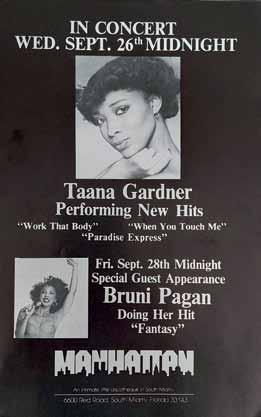









Welcome to edition 15 of the Hot Stuff magazine!











Welcome to edition 15 of the Hot Stuff magazine!
In this issue you will find some great contributions by myself, Spanky Dee, Dimitri From Paris, Koe Rodriguez, Jef Hecker, Wildstyle Guy, The Dutch Graffiti Library, Anderas Hellingh, Brandon Himmel, The Rambo Boy$ and Bobby Smith.
Spanky dee did an Interview with Roy Ayers in april 2003. As a big fan of Roy Ayers his death was a shock to everyone and to remember his great work you can read this interview in this issue. In issue 3 there was a great interview with Marlon Mclain which Bobby Smith had about Pleasure and his solo work. Because the very limited amount of printed copies, I reposted it in this issue.
For those who don’t know me yet, I have already collected many disco-related items, such as magazines, books, acetates and, of course, records! Like me, there are many other music lovers who have interesting stories to tell, know about the music’s history and have certain memorabilia.
This magazine includes a wide range of interesting articles on disco, jazz, rap, hip-hop, funk, house, rollerdisco and the graffiti & breakdancing culture. Furthermore, you will find vintage advertisements and magazine articles mainly from the 1970’s to the 1990’s.
Enjoy!
Groetjes, Discopatrick
Editor Discopatrick
dE sign - Layout
Cov E r iLL ustration
Contributing Writ E rs
Discopatrick Suus
Andreas Hellingh
Bobby Smith
Brandon Himmel
Dimitri From Paris Discopatrick
Dutch Graffiti Library
Jef Hecker
Koe Rodriguez
Rambo Boy$
Spanky Dee
Wildstyle Guy
© Discopatrick 2025
Jef Hecker
James “Koe” Rodriguez is a recognized visual artist, Hip-Hop scholar and an entrepreneur. His work has appeared in published books, domestic and international magazines, documentary films, group photo exhibitions and on lifestyle apparel. Over the years he has interviewed and captured such notables as: The Cold Crush Brothers, Rakim, LL Cool J; Jay-z, KRS, Wu-Tang Clan; Kenny Dope, the TATS CRU and Sal Abbatiello of the Disco Fever.
In 2005, Rodriguez curated his first group photo exhibition in Brooklyn, New York entitled ‘3 The Hard Way.’ The exhibition featured the works of renowned New York photographers, Joe Conzo, Ernie Paniccioli and Jamel Shabazz, and represented the first time all three photographers exhibited their timeless works under one roof. That year, Rodriguez would go on to pen a powerful afterword in Shabazz’s acclaimed book ‘A Time Before Crack’
before heading to Paris, France to helppromote the seminal sneaker documentary, ‘Just For Kicks,’ in which he co-starred.
Rodriguez is the Owner / Founder of Koe Rodriguez LLC, a sole proprietorship specializing in creative representation and media licensing. The company represents a number of renowned clients, such as: Martha Cooper, Ernie Paniccioli, Joe Conzo; Jamel Shabazz, Henry Chalfant and Thirstin Howl the 3rd. In conjunction with his clients, Rodriguez has worked on a number of international lifestyle projects with Adidas, Montana Cans, Sony; Nike, TriStar Pictures, Puma; ESPN+, Beyond The Streets and the Rock & Roll Hall of Fame, to name a few. He is the owner / founder of the curatorial apparel and art brand ATW (www.atwcrew.com).

Growing up in North Jersey during the ‘70s and ‘80s, there was no shortage of partying. Whether it was a basement, church hall, block party or nightclub, the jams were good ‘n plenty. Although I had been attending parties since the late ‘70s, it wasn’t until ‘86 or so that I was able to experience nightclubs in New York and New Jersey. During the ‘80s and ‘90s, some of the most iconic clubs for Hip-Hop, Freestyle, Reggae and House were in Manhattan, the Bronx, Queens, Newark and Jersey City. Back then, “clubbing” wasn’t just a social or recreational activity, it was a rite of passage; and for many, a way of life.
For the past 40 years, I’ve collected a number of things, especially in the realm of art, music, fashion, tech, and Hip-Hop culture. Among my many possessions are party flyers. Whether I was shopping or chillin’ in Jersey or any of New York’s 5 Boroughs, I would always grab a few club flyers during my travels. As a creative and a graffiti artist, I was more partial to flyers with photos and great art and design, especially anything hand-drawn. When I began globetrotting and doing special events in the 2000s, the collecting continued. Flyers for events in Paris, London, Brazil, Berlin, Los Angeles, Miami, and of
course, NYC, were diligently procured and ultimately preserved for posterity.
In 2024, I finally committed to organizing my entire flyer collection. Laborious at best, I made it happen and carefully extracted years of funky jams from old photo albums and manilla folders, categorized them into genres and cities, and then relocated the entire lot to an acidfree, 3-Ring binder for proper admiration, and preservation. Many flyers were digitally archived as well. As Hot Stuff has become one of my favorite publications to share cultural gems with fellow collectors and purists alike, it was only fitting to share a few of my favorite flyers from the ‘80s, ‘90s and 2000s. And unlike some collectors who cop from auctions and private sellers and who have no personal connection to their acquisitions, the flyers featured here represent cherished personal experiences, and true love, passion, and respect for urban culture and the arts that fuel it. Enjoy all of the flavor, and catch you at the next jam!
All flyers courtesy of the Koe Rodriguez Archives. Words and flyer centerfold © 2025 James “Koe” Rodriguez. All rights reserved.
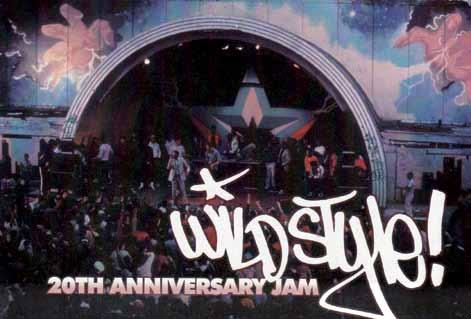

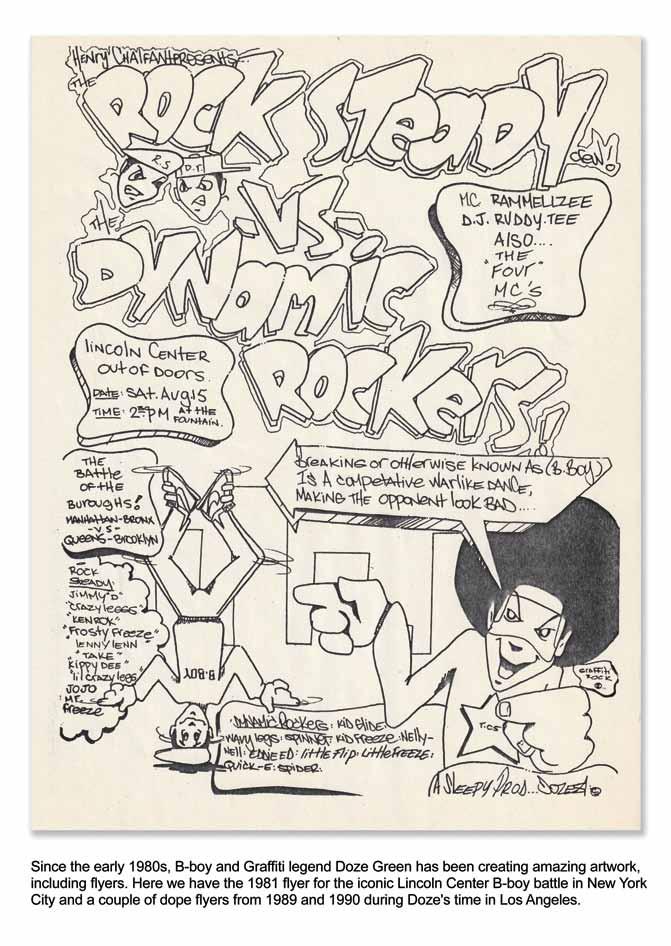



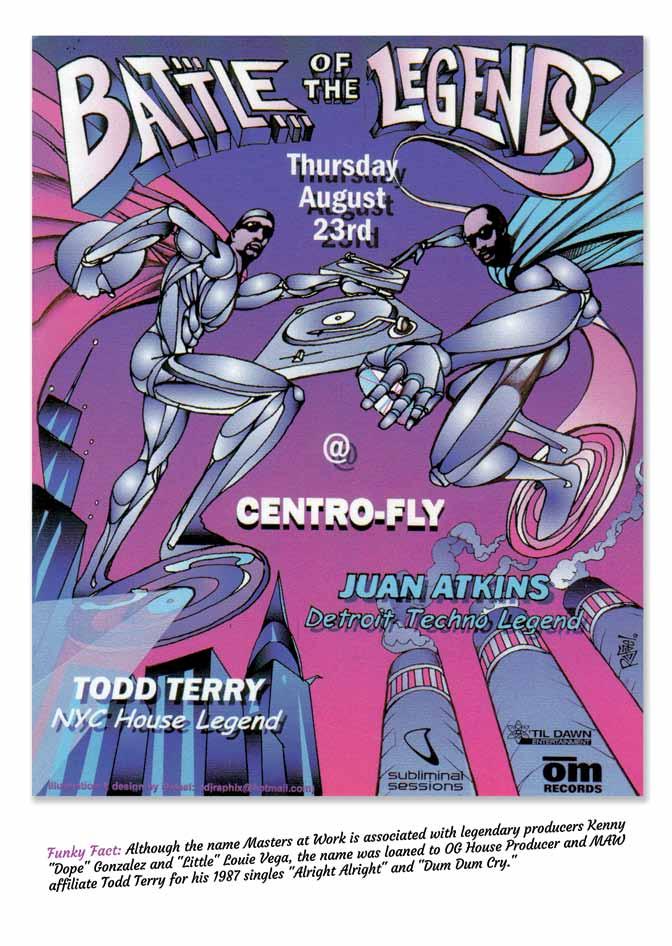
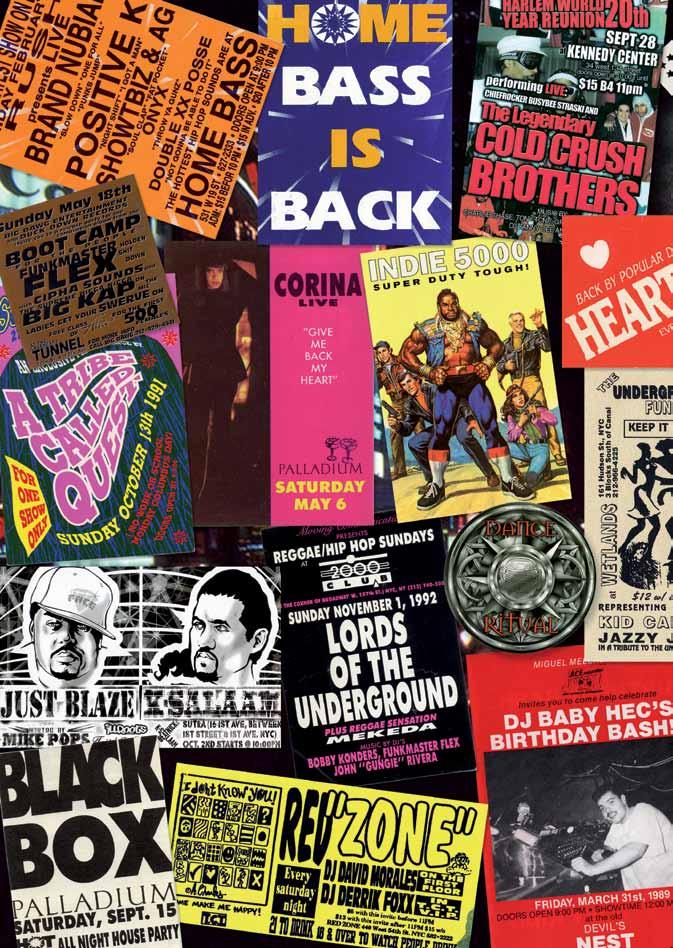
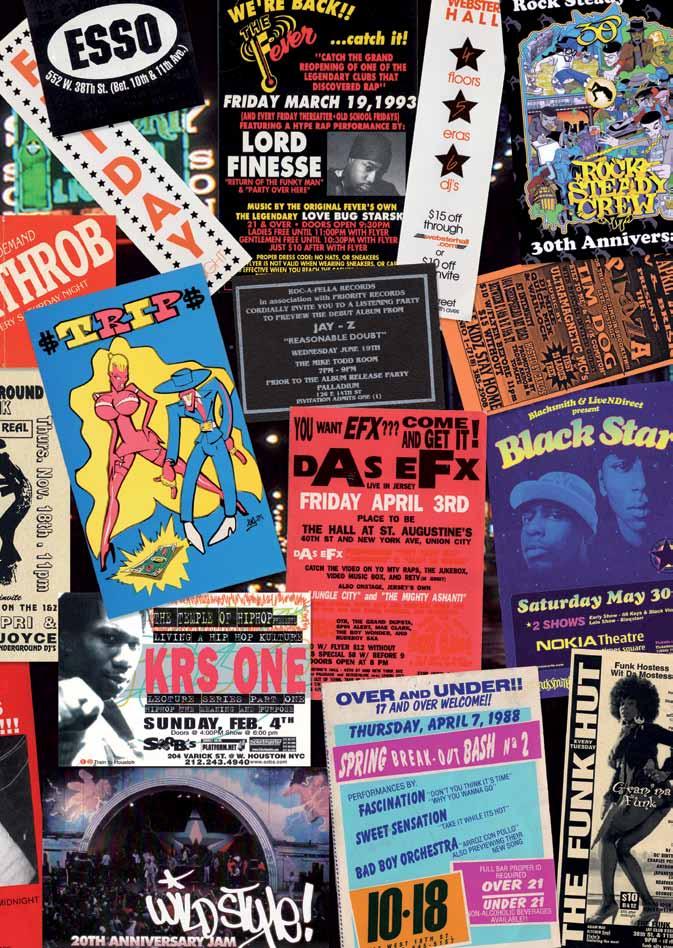

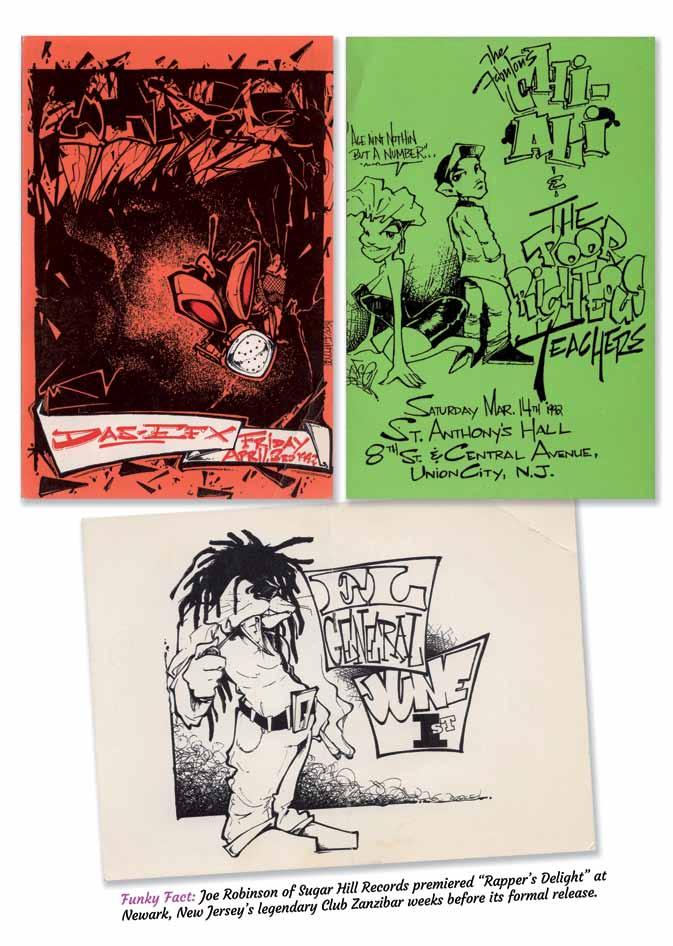
“i C an’t ESC aPE FRom m US iC”
by
Marking the recent passing of Roy Ayers, Spankie dug out an interview he did with the widely beloved artist in April 2003. Ayers was about to start a string of gigs in Australia and Spankie was very fortunate to speak to him for the local clubbing/music/fashion magazine called Inpress.
How is it that an artist can finally create his or her own identity? How long does this kind of process take? How many succeed?
Let’s take a quick look at a few examples of groundbreaking artists who have managed to truly carve their own niche. Once you’ve been exposed to the paintings of Mondrian, it is almost impossible to not recognize his work. The white backgrounds, the intersecting grids of black, red, yellow and blue lines clearly instantly identify the artist. There is no doubt as to the authenticity of an original, or to the clear origins of an imitation. In the world of music, Soul Brother Number One Mr. James Brown was also able to define a sound for himself that is easily distinguishable from the countless ones he influen -
ced or that directly imitated him.
Roy Ayers is another one of those rare artists who has managed to whittle a vibraphone mallet that only he can wield. When asking him about this he agreed that he occupies his own little zone. He didn’t boast about it, but he definitely does recognize it.
When I pressed him and asked how this happened, I was hoping for a mind-blowing story but also expecting something simple. I thought a good place to start would be to ask about the Ayers sound. In a similar way to which Curtis Mayfield’s music can be easily distinguishable from other soul and funk music of the period due to his falsetto singing and the strange way he tuned his guitar, so to a Ayers pro -
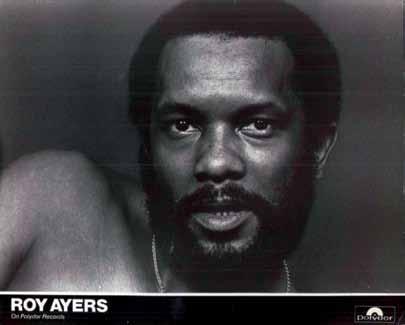

duction has a certain tonal quality. What is it about his sound, style of playing and production that sets his work apart?
“What I did in a lot of my music was concentrate on clusters of minor 9th chords. These are very defined chords and you can hear them especially on songs like ‘Everybody Loves The Sunshine’ and ‘Searching’. These chords are what make much of my music sound so intriguing and in a way mesmerizing. They can captivate people and get their head into another place…it’s a groove.”
I asked him if this concentration on certain chords was something that came from playing vibes or was it just a sound that he was aiming for.
“Oh, it definitely comes from playing vibes. Even though a lot of the time when I was producing I would play keyboards or piano on tracks, I would not be able to separate those sounds from the ones coming from my vibes. Even though the backbone of the track may be a piano line or guitar line, because I would lay it down first it would always have that certain ring to it that comes from the vibes.”
During the interview Ayers quoted Duke Ellington by saying “Music is my mistress.” When you listen to Ayers talk about music it is like he is talking about his very soul. The energy and devotion that comes out through his voice after all these years, all
these albums, all these interviews; it displays his complete and sincere love for music. He said, “Music is my escape, but I can’t escape from music.”
In the 70s Ayers generally released at least two albums a year. ’76, ’77 & ’78 saw him release three albums each year and in 1980 he released four. And I’m here to tell you; it is not easy to find a shit one! Also in 1980 he set up his own record label, Uno Melodic, that showcased the talents of some former Ubiquity members like Sylvia Striplin, Jaymz Bedford and Ethel Beatty. The releases on this label, especially the 12” singles, are perhaps the most sought after of all Ayers productions, usually changing hands for over 100 pounds sterling a piece!
“I remember back in my early days of creativity, especially in the early 70s, that I was just so hung up on music and the way that it just ‘happens’. In the 70s I composed between 500 and 600 songs many
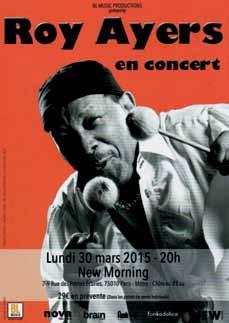
of which weren’t even recorded let alone released. Sometimes we would be in the studio for days at a time. I remember one time waking up in the studio with the tape rolling but we had all been asleep. I woke up the band and said, ‘Let’s get the hell out of here! This is crazy!’ I guess what I am trying to say is that music for me is something that just ‘happens’ and that is what I love about it.”
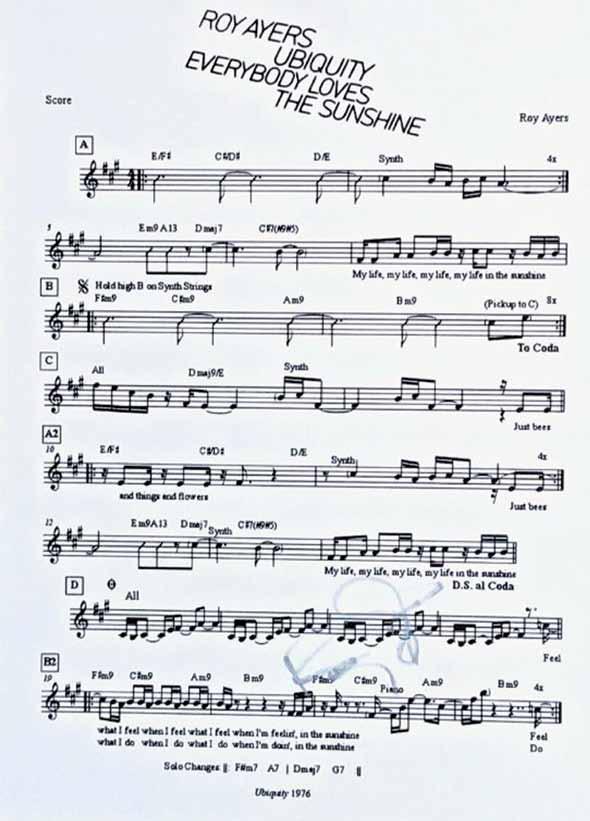

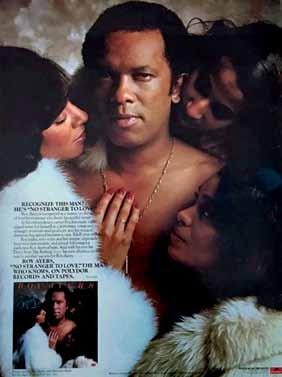

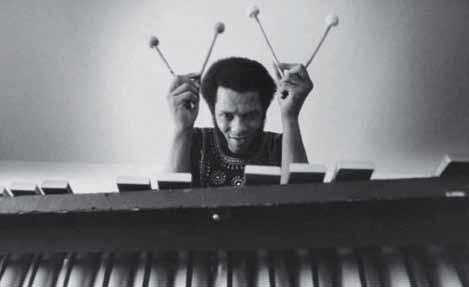
Particularly in the early 70s, many of the jazz world’s finest artists began to leave the more traditional camp and explore in the new realms of jazz-fusion. Many of these players, including Ayers and Donald Byrd, copped a lot of flack for this betrayal from the straighter sector, especially jazz critics. The critics had a second go at them in the early 90s when they teamed up with a lot of people in the hip hop world. Were they aware of this criticism at the time and did they care at all?
“No, Donald and I didn’t care. Donald is older than me. I am 62 and he is about 67. We both toured together with Guru and the Jazzmatazz project and we had so much fun hanging out with all the hip hoppers even though we are both older guys. We didn’t care what people were saying then as much as we didn’t care back in the mid-70s when we were really pushing jazz into new directions. Being a jazz musician but also being able to play with hip hoppers, R&B artists and even house music artists has allowed me to do very well for myself not only musically but also lucratively. I guess that comes from the fact that I am versatile. There are many other jazz artists who have managed to get a musical reward for what they have done but have not reaped any kind of financial benefit.”
How about the forming of Ubiquity in 1970? Was that something that “just happened” too? Did it just happen that Ayers
managed to pull together some of the most amazing musicians, many of them relatively unknown, on a rotating basis and keep pumping out work that broke down barriers and opened up doors?
“Yes, it just happened that way. They just came to me at different times and showed their interest in wanting to play with me. Sometimes I would have to tell them that I didn’t need a bass player or whatever at that time but I might give them a call when the time comes. Many of the members of Ubiquity went on to lead their own band or pursue a solo career and I feel very proud that I had the opportunity to play with them and also had some kind of input into their success.”
This is reflected conversely by the fact that Ayers was a vibesman for both Chico Hamilton and Herbie Mann before he was able to enjoy his own time in the spotlight. This is one of the things about the world of jazz that keeps it alive, and that is the free trade of players and artists between labels, groups and sessions. All of these times of playing together for brief or extended periods form strong links that can be leveraged at a later time.
It is now the 41st year of Ayers being represented in the recorded world of music. He is still working incredibly hard, even though as he says, “I am 62 now so I have to tell all these youngsters I am working with to take it easy on me!”
Considering that Ayers comes across as such an open and positive person it is really little wonder that he continues to attract artists to him as much as he ever has. In the late 80s and early 90s he basically gave birth to the Acid Jazz scene and now he is heavily represented personally or through sampler in house music, with the likes of Masters at Work and Jazzanova being super keen to work with him. He has a new album coming out in May with Erykah Badu entitled “Mahogany Vibes” and is appearing live at The Prince Of Wales in St Kilda (Melbourne) on Sunday, April 20.
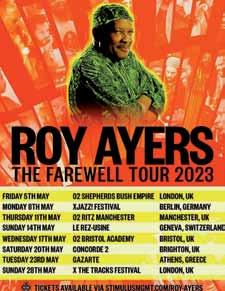
Can this man be stopped? He ain’t got time to be tired! He’s a superstar!
“It is such an exciting career that remains exciting and…well it’s like ‘everybody loves the sunshine’…That’s how I feel.”
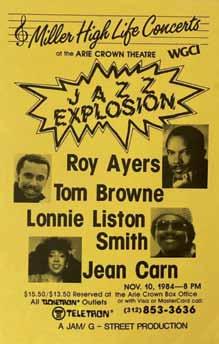
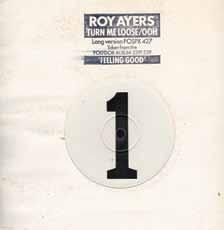



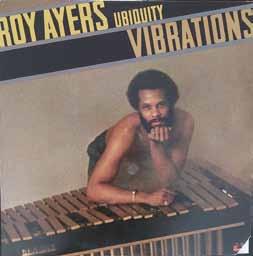
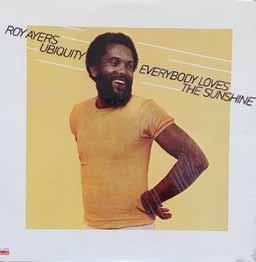


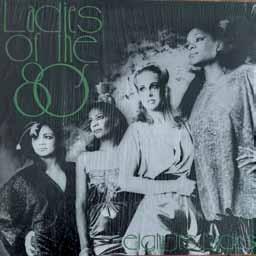

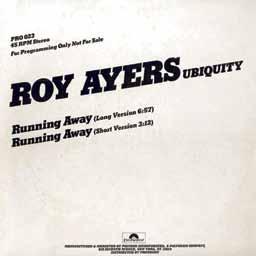
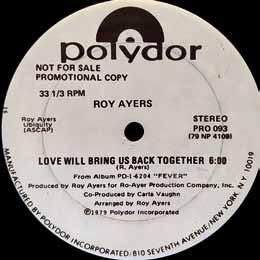


Spankie selected these quotes from “Rap n’ Rhythm with Al Gee”, a syndicated radio program that ran from 1973 to 1977. Recorded in New York and sponsored by the U.S. Army Reserve, the show was hosted by widely respected DJ Al Gee who had long and personal connections to many of the soul, funk and disco artists he interviewed.

Roots:
“Los Angeles, California is where I was born and raised. I love that place and I’m going back eventually. I live here in New York but Los Angeles is my home originally.”
“My mother and older sister played piano. I come from a very musical family that enjoyed all types of music from religious to jazz to gospel and every facet. My basic musical education came from Mrs. Elma Hightower. She was a great music teacher and she taught not only myself but Lionel Hampton and many other
greats. I’ve been around music all my life, though. I’ve been surrounded by it. I started as a professional musician, joining the musicians’ union in 1961 in Los Angeles, California.”
“I’ve only mastered one, I think, as far as really playing an instrument well, and that’s the vibraphone. But, I’ve studied piano, the trumpet, the flute, and all percussion instruments. In the studio, I find that I can execute better than other people because I know exactly what I want. So, I just go ahead and do it myself. And, it also saves me a little money in my budget.”
Writing for voice and for instruments:
As my career has been growing I have been concentrating on vocal arrangements as well as instrumental arrangements. That’s why I call my music ‘ubiquitous’ – ‘being everywhere’. I also play a variety of music, from jazz, to a little R&B, to pop and a little bit of this and that. And I like that. But, I think it is a little more intricate writing arrangements and parts for instruments compared to voices. I’d just say that it’s the technical ability and the ability to really acknowledge how, for example, a piano or a guitar can enhance your arrangement.”
Playing nightclubs versus other gigs:
“I used to really get into the intimacy of the nightclub atmosphere, but now I really dig anything, you know? I found that people enjoy music wherever it is if it’s good music and it’s something they can relate to and get down and groove to. The place doesn’t matter. And, to me it’s the same way. If I can get a vibration and a feeling with the audience, it makes me feel like I’m appreciated and vice-versa. It doesn’t really matter to me as either one is groovy.”
The connections between musicians:
“There are a lot of trees – I call them ‘trees’ and give my own definition to them. You take musicians like Miles Davis, Herbie Mann, Horace Silver and so on. All those gentlemen have had great musicians with them and from them have come
more. Take Miles Davis: Herbie Hancock, Cannonball Adderly, John Coltrane, Bill Evans, and more. And all these guys have formed groups and they come out with other musicians. The trees keep growing and eventually there are all these musicians everywhere!”
I came up in the church, you know. I was around the Methodists. But, my mother and father allowed me to go to any church I wanted to. So, that was groovy, because I went to Catholic, Baptist, Methodist, Christian Science, Science of Mind – everything. It seems that it gave me a good insight for musical concepts and ‘that feeling.’ You know, that early feeling that you get that gives you a release later on. It seems as though it enhanced my style or at least where I’m going to. As you can see my music is not, at this point, one specific music. It’s a variety of ‘musics’ in one. Especially after the first year at Polydor Records, I really started concentrating on trying to be ubiquitous, like the name. I was really thinking in those terms. ‘Ubiquity’ means a state of being everywhere at the same time. In order to be everywhere you have to have your records everywhere and everyone has to have one of your records. But then, you have to try to appeal to different people in different places. So, that’s why I’ve tried to arrange my music around a ‘variety of musics’ and to reach a vast amount of people.”
I’ve always been attracted to the Jamaican aesthetic in music. Their musical culture is rooted in American Soul which has been totally re-invented as Reggae, and furthermore its Dub and Version sub-genres, the latter being a very large building stone of the modern remix culture.
While Jamaica’s biggest and most known output is a variation of reggae, there have been a decent few odd ‘Reggae Not Reggae’ releases. I’m showcasing eleven of my favorite ones here, along with some from nearby Caribbean islands.

1. beres Hammond - Keep My Wheel turning -Joe g ibbs Music-1979-LP
This is probably one of the closest Jamaican attempt at Philly Disco, all that’s missing is a proper 12’’ of this LP cut.
2. E t webster - My Music -soM b records-12”
Distinctively Caribbean sonically, but with a deep Disco vibe. Both versions are great.

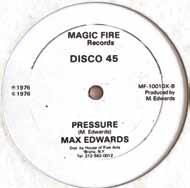

3. Max Edwards – satin soul- Magic Fire records – MF-1001dX-12”
A great mix of reggae and soul, with this downtempo Barry White cover. For maximum effect, it goes into Dub midway.
4. r isco Connections - i ’m caught up- i sland series – br 1-12-1980-12”
One of the holy grails of Disco Reggae. When musicians and sound engineers that recorded reggae everyday, dabbled into Disco, it gave it this unique raw and powerful sound.


5. Equals - n obody’s got time - i CE -1980-LP
There are 3 other versions of this, the most known being Paradise Garage cult classic: “Time Warp” by Eddy Grant who wrote it. Here he produces the most Disco version of them all for his band The Equals.

7. b oogsie - Can’t you see me -s harc – ss1079 -1979- LP
There are many Steel Band LPs out of Trinidad, with plenty of covers that are fun, but rarely that great. This LP is definitely among the better ones, and offers a great dancefloor rendition of Roy Ayers’ ‘Can’t you see me’.

6. Marcia Griffiths – Harmony -High n ote 12’’
Jamaican artists have always been covering the hits of the day, but always almost in a Reggae style. This cover of a Giorgio Moroder penned song for Canadian Suzy Q, stays uptempo, with a lovely island flair, far from the original’s synth pop sound.


8. s heila Hylton – d isco reggae-Harry J records – HJ d -277-1978-12’’
A little on the cheesy side, but still a great combination of uptempo Disco, Reggae and Calypso on 12’’.

10. d ennis Walton – sweeter Love - g iah – aCr 8267 -12’’
Great vocalist, great song, with a vibe reminiscent of the Third World uptempo tracks. A major underdog record.
9. Flatbush ave r ythm band – voices i nside My Head -starburst records –sbr 510-1980- 12’’
On a label that’s rich with classic Calypso releases comes this great double header. A side has a cover of Stephanie Mills, while the flip goes deeper with a midtempo and fat sounding version of Police’s hit.
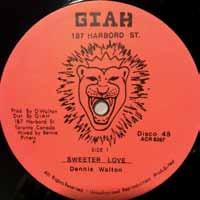
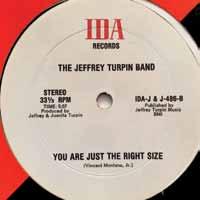
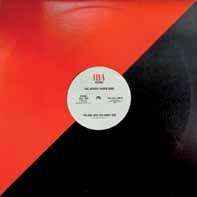
11. t he Jeffrey turpin band - you a re Just t he r ight s ize - ida records – ida-J & J-48- 12’’
Big collectors item here, with an Caribbean flavored version of Salsoul Orchestra
Louis “Sabu” Martinez was born on July 14, 1930, in El Barrio, Spanish Harlem, New York. From an early age, he showed a natural talent for rhythm, turning everyday objects into percussion instruments. By age eleven, while other children played in schoolyards, Sabu was already performing on 125th Street, earning quarters for his music. However, his early years were far from easy. Reflecting on his childhood in a 1968 interview, he stated, “Maybe you’d like to know what I did before I reached eleven? I sold drugs and booze, broke windows, stole, fought, lived among murder and in slums, fighting like a savage to survive—with fists and picklocks. You may write that. It’s a part of my life...” (Lasse Mattsson, 1968).
His professional debut in 1941 marked the beginning of an extraordinary musical career. In 1944, he spent time in Puerto Rico, deepening his connection to his roots. At seventeen, he joined Joe Loco’s trio, opening doors to collaborations with jazz musicians. This led to work with cats like Art Blakey, with whom he performed and recorded albums such as Orgy in Rhythm and Cu-Bop. A defining moment in his career came in 1948 when he replaced Chano Pozo in Dizzy Gillespie’s band. Pozo was tragically killed in a nightclub brawl that same year, and just three days later, Sabu stepped in to fill his role. He later spoke about this period, recognizing Pozo’s influence: “Chano was cut down by a bullet... He was my first major influence. And three days later, I took his place with Dizzy” (Nat Hentoff, 1957; Lasse Mattsson, 1968).
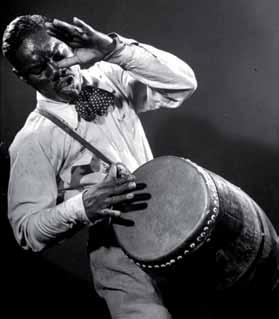
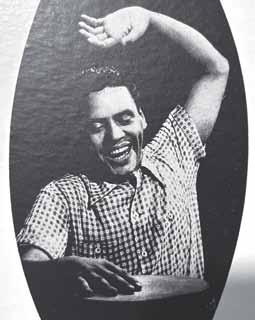

Sabu was a major force in the 1950s CuBop scene, he appeared on many prolific and influential recordings. In 1957, he released his first album as a leader on Blue Note Records: Palo Congo, a cornerstone of Afro-Cuban jazz. However, this wasn’t

his first time on the label; in 1954, he had already played alongside Art Blakey on Message from Kenya. These recordings blended traditional African elements with improvisation and Swahili chants. Blakey himself praised Sabu’s ability to integrate with the band, “Sabu is the only conga drummer who doesn’t interfere with my drumming and who doesn’t get in the way of the musicians when they’re taking solos” (Nat Hentoff, 1957).
Although Sabu was a master percussionist, he never learned to read music. In a 1957 interview, he explained his intuitive approach: “I feel the beat. I have been in jazz since 1947 and consider myself a jazz musician, so I have no problem feeling the rhythm and knowing what to do to express what I feel and to blend with the group” (Nat Hentoff, 1957). This organic connection to rhythm was part of what made his playing so dynamic and powerful.
Like many jazz musicians of the late 50s, Sabu struggled with addiction. The drug took a toll on him and the jazz world as a whole. For a time, he disappeared from the music scene, taking on various jobs, including managing a strip club in Baltimore. With the support of friends, he eventually returned to music (Hipwax, 1997).
In 1960, Sabu collaborated with Louie Ramirez to record Jazz Espagnole, an album that redefined Latin jazz. It merged Latin rhythms with interpretations of jazz standards in a way that had never been heard before. Many consider it his finest work, his Love Supreme. Unlike many recordings that either lean heavily toward jazz with Latin influences or vice versa, Jazz Espagnole achieved a true balance. The arrangements and musicianship made it unique, and Horace Silver’s influence can be heard in the compositions and chord progressions, enhanced by Sabu’s signature play. In an interview, Sabu stated, “You can’t play Latin conga to jazz... At least, you shouldn’t. I play the conga drum as a jazz instrument, not as a Latin addition”.

Using the conga drum this way is still relatively new, and very few conga drummers can express themselves as jazz musicians yet. When asked about the differences between playing jazz conga and Latin conga, he explained, “I often leave more spaces in jazz, and I put more pressure on two and four. Actually, I feel jazz in two while in Latin music I have to feel the beat
on all four beats pretty evenly. Another thing I do in jazz conga is to stretch my notes. I can deepen and stretch the beat by placing my hand heavier on the skin” (Nat Hentoff, 1957).
Over the years, Sabu married several times and had many children. Two of his sons, René and Johnny, followed in his footsteps as drummers, with one eventually joining the Swedish band Hot Salsa (Hipwax, 1997).
His family also contributed to his 1973 album Afro Temple, a personal favorite of mine, and a true holy grail for heads of Latin and percussion music. It would be the last album Sabu released as a bandleader. In this expressive work, he takes the listener on a journey through rhythm and sound. Spoken word passages confront the painful realities of colonialism and displacement. Recorded alongside his students and fellow musicians, the album weaves layers of percussion and wailing saxophone into a hypnotic soundscape, one that truly transcends when you open your senses.
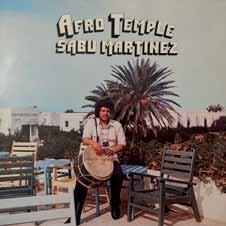
Afro Temple (1973)
In 1967, Sabu moved to Sweden with his wife, Agneta, where he continued his musical journey. He collaborated with artists like Cornelis Vreeswijk and Merit Hemmingson, expanding his influence in European jazz circles. In 1973, Sabu formed the group New Burnt Sugar and published a book of conga exercises. Despite his successes, life was not always easy—he faced racial hostility and was forced to move. Nevertheless, he remained dedi -
cated to his music, sharing his knowledge with future generations (Harris, n.d.).
His final recordings were for Brief Encounter by Debbie Cameron and Richard Boone in 1978. On January 13, 1979, he passed away at 48 due to complications from a stomach ulcer (Harris, n.d.).
The last session Sabu Martinez played on (1978)
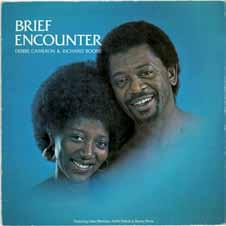
Francisco Aguabella once shared an anecdote that captures Sabu’s selflessness. While living in Los Angeles, playing with different bands but struggling financially, Sabu once borrowed Aguabella’s spare conga set. When asked where his own drums were, Sabu replied, “I sold them to leave something for my children before going out of town” in Spanish: “las vendí para dejar habichuelas para mis hijos” (Hipwax, 1997). Even in difficult times, his devotion to his family remained steadfast.

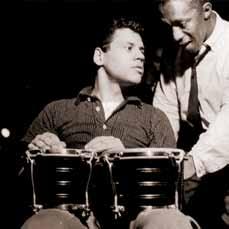
Thank you, Sabu Martinez, for the music, the passion, and the rhythm that continues to echo through generations. Your legacy has left an indelible mark, inspiring countless musicians and heads around the world. Rest in music.
references
Harris, C. (n.d.). Sabu Martinez. Blue Note. https://www.bluenote.com/artist/sabumartinez/
Hentoff, N. (1957). Cu-Bop! Art Blakey’s Jazz Messengers Plus Sabu [Album liner notes]. Jubilee Records (JLP-1049).
Hipwax. (1997). Who was Sabu? http:// www.hipwax.com/sabu/sabubio.html
Mattsson, L. (1968). Sabu Martinez: Percussionist with joie de vivre. Orkester Journalen. http://hipwax.com/sabu/OJ041968. html
by DUTCH GRAFFITI LIbRARy
In October 2018, Dutch Graffiti Library published the book ‘Disz. The first Dutch writer bombing the New York City subway.’ Finally after more than 30 years an answer to the question “What is a young man from The Hague, doing bombing the one line in the 145th Street Tunnel with Bodé nudes?” asked in the book ‘Spraycan Art’ has arisen.
After publishing the book, we received messages from all over the world. Disz was more well-known and influential than we had imagined. In Australia, San Francisco, New York, Berlin, and of course the Netherlands, he was remembered and respected by old-school writers.
When you publish a graffiti book, it’s almost impossible to be completely comprehensive—to track down everyone mentioned and to get all the photos you want. That was also the case with the book about Disz. But for us, the intensive research didn’t stop in October 2018. There were still a few loose ends...
One of these loose ends was hardcore evidence—specifically, what we were
looking for: clear pictures of a Disz whole car that René Westhoff a.k.a. Disz painted on Sunday, 16 February 1986, at 2:30 PM in the One Tunnel, New York City.
In the book, we published the only known “picture” of that whole car—a blurry, blown-up, cropped photo of a door in Disz’s room from the late ’80s.
During our research for the book, this was considered a diamond, as we couldn’t find any other images.
Driven by our desire to be thorough, we were convinced that someone, somewhere, must have taken better photos. Few subcultures are as well-documented as graffiti. We kept digging and fishing through digital archives across the globe.



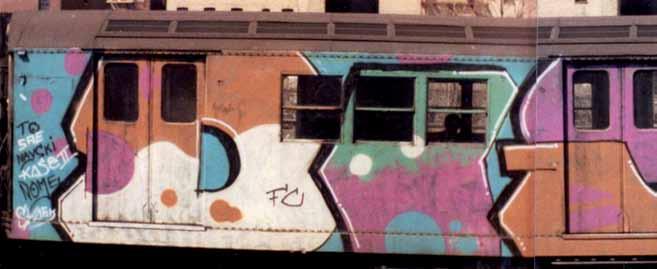
There were no results—until February 2020, when we received a DM from Queens, New York:
“Sane took the photo and it’s a part of my collection. It was a great time to start writing and catching photos of whole car after whole car on such a dynamic subway line as the 1 line. To see the Disz whole car in 1986 done by a foreigner that nobody had heard of was just a great added experience” SMITH, New York, February 2020
Outtakes of the book ‘Disz. The first Dutch writer bombing the n ew york City subway.’
Disz: [… When the fill in was done I started the lizard that I wanted to do on the side of my top to bottom whole car DISz and I think the lizard turned out OK and I even did some rocks with it. Once I was bombin’ again it felt so good to be in the tunnel again, really it was. After I’d started the final outlining, which was a little disappointing, I found that I needed a ladder cause I felt it is so hard to stand on that small edge of the train, hang back against the wall, hold on to one hand and still spray and then make a straight line. So I went to the other side of the
tunnel to get myself a ladder whom are in the tunnel, surprisingly enough to me. That was another thing that surprised me.]
Disz: [… Cause my final outline didn’t come out too well I hurried it some in the end and also cause I was very tired by now. So my outline on my Disz wasn’t too fresh but I think the lizard and rocks did come out pretty good. ]
Disz: […By the time I left the tunnel, at about five o’clock it was crowded with writers so I went to the other side and got on the platform there and took the downtown train. In the train I felt so fuckin’ ‘happy’ knowing I’d done it, I’d done a whole car Disz and mainly on my own and the other writers like it!]
“Times like that were all the time if you knew the right people and Disz was very lucky to bump into Sane and then the rest of the gang. Sane had tried himself to bench at 125th and was chased away from there so he had to bench uptown closer to where we lived. It was rough in those days! SMITH, New York, February 2020

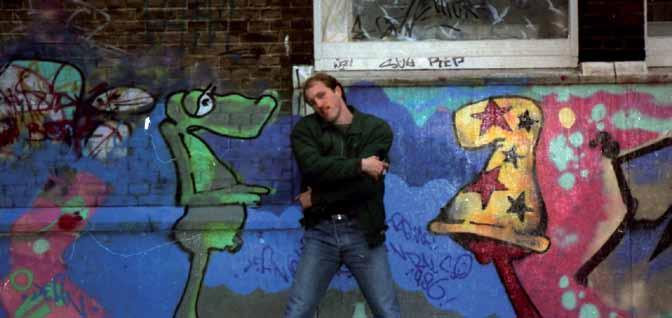
Note by Dutch Graffiti Library:
Another missing piece of the Disz puzzle is revealed… thanks to SANE(RIP) and SMITH, two brothers who grew up in Uptown Manhattan. They began tagging in the mid-1980s and truly hit their stride at the tail end of the train era, around 1989. They made their mark by moving on to large-scale productions on city landmarks—most famously on the Brooklyn
Bridge in 1990. Their relentless tagging campaign brought them under widespread scrutiny by the authorities, ultimately leading to SANE becoming the first graffiti writer to be arrested and charged with third-degree criminal mischief. All charges were later dismissed following SANE’s untimely death in October 1990.
from the Big Daddy Magazine Issue 12 2002 Interview by Short
Boris Tellegen a.k.a. Amsterdam based Writer DELTA has, over the years, developed a unique, immediately recognizable abstract letter style that is reminiscent of futuristic architecture. He’s come from a traditionalist graffiti background and studied product design and has now built on his technique over the years to the point where he has collaborated with architects, displayed work in galleries, designed record sleeves and packaging and has had his artwork widely published. Big Daddy caught up with this elusive and well-respected artist for a brief interview:
BD: Lets start with the basics. How did you first get into writing and who were your early influences ?
d: I started writing in ’82, ’83. My very first influences were the Punk/Ska movement with only tags like logo’s. After a while I saw a huge Quick throw up in the city. I realized that it was possible to fill surfaces with spray paint instead of only doing lines. Then a gallery brought a lot of NY artists over at that time; zephyr, Seen, Noc, Dondi, Futura, Rammelzee, Quick, Blast, Blade,…. That was a big influence on us. Then the book Subway Art came out, and the films Beat Street, Style Wars, You know….



bd: Did you have a mentor ?
d: No I didn’t have a mentor. We were the first ones in Amsterdam to do pieces so we could only learn from New York books, photos and artists.
bd: What was the Dutch scene like at that point in time ?
d: Small. And very local. What happened outside of Amsterdam, we would not know. But the scene was very competitive, a lot of progression.

BD: Obviously there were existing 3D elements in the artform previously, but you brought in an extra dimension of realism. When did you start to make this transition ? How did it come about ?
D: Since I was learning for product design in school, I was trying for some time to apply that knowledge to letters. You know, to design letters as if they were products. That took me quite some time and effort. That was somewhere in’91.
BD: Were you aware of the work of Flint707 and Erni at the time ?
D: The only piece by Erni I knew was the one of the cover of Subway Art, which I thought was the best one on the cover
But no, I hadn’t seen anyone else do 3D. But to me the point was not to let the piece look as 3D as possible by not doing outlines and just shading. My interest was with the shape of the letters in general; the sides of the letters, and to remove the difference between the font and the sides of the letters. The shape could continue around the corner. Designing it. Therefore, I preferred-and I still preferto use regular outlines, to emphasize the shapes and the tensions.
BD: Do you still work illegally ?
D: Well now and then I still do a piece, but not as often as before. You know, to keep the feeling.

bd: How have you managed to pursue a career using the same pseudonym ?
d: You mean without being afraid of being prosecuted ? You have to use common sense in choosing the location of tags and pieces, and in choosing the alias.
bd: You were doing some elaborate 3D styles illegally. How quickly could you do them ?
d: It is just like doing a piece in general: sketching, filling in, outlines, touching up. Anything from a couple of minutes to a couple of hours.
bd: What do you think of the current Dutch train scene, has it progressed ?
d: I must confess that I am not very aware of the current train scene. I do see a lot of pieces come by, but the names don’t stick in my mind. Maybe that says enough of the current scene. It seems that nowadays the scene is more local again, like in the 80’s, with not so much awareness of history or other countries. Which is not necessarily a bad thing.
bd: “3D style” has become a widespread format in the movement and a large amount of artists worldwide base their work on it. How do you feel about this ?
d: I am not very interested in 3D shading techniques. Most 3D artists put more effort into techniques than into the funk of the piece.

bd: You reinvented your style into a clearly related but very different format. How did you go about doing this ?
d: By progressing over time, little steps each time.
bd: These days, how would you say your time is divided amongst your various priorities ?
d: Nowadays I am in the lucky position that I can more or less choose which work I want to do. I do not have to take on anything.
bd: You seem relativity low profile in term of web, media, etc. How do people make contact with you who are interested in your work ?
d: Word of mouth. Search the internet extensively. Don’t try to search for the word “Delta” only.

bd: How focused are you on the gallery scene-how do you feel about that whole issue overall, and what exhibitions do you done recently ?
d: I like to do paintings and structures, prints, installations, and murals on locations. I had a show recently in Tokyo, in Anda. It was a combination of photos by Michal Butink and graphics by me. It was about structures. There are some other shows coming up.
bd: Have you had to compromise in any way to fit into it ?
d: I don’t feel that I have to compromise, actually I think it is the most personal thing to do.
I’ve never been to Japan but Japan has often come to me. Not in my dreams, but in my collection. Back in the days before Discogs, GEMM or eBay, collecting was a physical activity. Getting out was the only way as we had to visit record stores, thrift shops, flea markets or meet fellow connoisseurs. And keep our eyes wide open while on city trips. Now we don’t need to leave home as we get vinyl records delivered like a pizza (same size). How convenient. If it wasn’t for the world wide web, there would be many missing pieces in my puzzle and some I wouldn’t even know their existence. But of course, digging in the crates and getting dusty fingers will always be the ultimate experience… I’ve just spent 8 hours searching black gold at the Mega Record & CD Fair in the Netherlands aka the largest vinyl show on earth. Exhausting but I can’t help coming back every year. Sometimes it seems I actually spend more time looking for new stuff than enjoying my own personal museum. More is never enough. I guess we collectors can’t stop burning too much cash on things we don’t really need in life… do we ?
I can’t read Japanese websites as I don’t speak the language. Lost in translation. Yet all roads lead me to Tokyo when I’m on the hunt for hip-hop memorabilia and other rare artifacts. So here are some of my online adventures in the land of the rising sun.
It all began in 1999 with the movie Ghost Dog. That’s the first item I ever got from Japan. Not the movie itself but the soundtrack. Not the so-called album (blue front cover) but the real soundtrack with beats and instrumentals (white front cover) that was released by Victor Records only on compact disc, only in Japan. In the early days of e-commerce it wasn’t so easy to order an import CD from overseas. Argh got rid of the obi

strip because I didn’t know what it was ! Bootleg vinyl versions were also available but the official LP only arrived in 2020 thanks to 36 Chambers Records. Jim Jarmusch’s Ghost Dog is a wonderful tribute to Jean-Pierre Melville’s 1967 French movie Le Samouraï starring Alain Delon. It’s obviously more New-York, more hiphop, more Wu Tang. Just like the original theme composed by François de Roubaix, the R z A managed to deliver a mesmerizing score that stood the test of time. So funky simple and funky sample it makes me wanna read Hagakure or ride a Lexus like Forest Whitaker.
Like most my age, I grew up with Japanese cartoons of the 70s. Watching TV and waiting for the next episode of Grendizer aka Goldorak or Captain Harlock aka Albator… but my favorite has always been Captain Future aka Capitaine Flam in French. Did you know that originally he was a hero of pulp science fiction published in USA during the 40s ? I still remember the lyrics of the cheesy theme song that was created for French speaking markets. Fun fact, my friend DJ Daddy K from Brussels actually scratched snippets from the French LP « Mais vous êtes fou… Oh oui ! » and together with MC Benny B made in 1990 the first French rap hit ever. For decades this version by
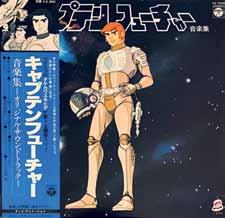
Jean-Jacques Debout was the only one I was aware of… until I discovered the original 1979 Japanese score by Yuji Ohno & Galaxy. Yuji Ohno is a jazz pianist and composer best known for his work on the Lupin The Third anime series but to me, his Captain Future soundtrack is second to none. It’s a jazz-infused space odyssey that stands out among anime scores of its time, a futuristic blend of funk, jazz fusion and disco that creates an otherworldly atmosphere and perfectly captures the spacefaring adventures of Captain Future. The best track imho is called « Kagayaku ginga no kanata e » which can be translated to « Far Away From The Glittering Galaxy » or « Beyond The Shining Galaxy » sadly it’s not available on the 1979 LP but on a Japanese double CD from 2001 with previously unreleased tracks. No wonder it was sampled by DJ Daringer for Benny the Butcher’s « Joe Pesci 38 » in 2018.
I was never interested in the Godzilla mo -

vie franchise but definitely impressed by Godzilla Minus One written and directed by Takashi Yamazaki in 2023, the first to win an Oscar. It’s heavily influenced by the first kaiju film directed by Ishiro Honda and produced by Tomoyuki Tanaka in the 50s. When I think of Godzilla aka Gojira, I see the metaphor for atomic bombings on Hiroshima & Nagasaki and I hear Akira Ifukube’s epic music. He was a Japanese classical musician best known for composing several Godzilla soundtracks as well as the monster’s roar by rubbing a pine tarresin-coated glove along the string of a contrabass and then slowing down the playback.
His 1954 « Main Title » also known as « Godzilla Main Theme » is a timeless masterpiece while his 1964 « Gojira Tai Mosura » has been sampled multiple times, the most famous being of course « Simon Says » by Pharoahe Monch in 1999. Naoki Sato’s original score for Godzilla Minus One is one to remember and his new recording of Ifukube’s iconic pieces called « Godzilla Suite » has the perfect umami taste. That’s why I can’t watch a Superman reboot without John Williams (it’s already painful enough without Christopher Reeve).
Yoshi Omori was born near Mount Fuji and came to Paris in 1985 to study photography. On his way he met French hip-hop pioneers and got to capture the burgeoning scene of the 80s. From his expat perspective were immortalized places like « le terrain vague » at Stalingrad or « Chez Roger Boîte Funk » at Globo nightclub. And people like Dee Nasty, Destroy Man & Jhony Go, NTM, Assassin, Mode2, Jay One, Colt,

Bando, Stomy Bugsy, Aktuel Force but also Chuck D & Flavor Flav, Spoonie Gee, Cash Money, Red Alert… These historical pics have been published in 2012 in his book Mouvement with text by Marc Boudet & Jay One. As described on the cover « We thought hip-hop, we lived hip-hop. Hip-hop, hip-hop and yet more hip-hop. Except at the time, we didn’t use this term, we used to talk about Movement. » A punchline from VICE magazine says it all: « Mouvement is still the only book you should buy on the beginnings of hip hop in France. »
Now we have playlists, yesterday we had compilations. I’ve always loved compilations, some are good some are bad, but what an easy way to enjoy music. There are comps about anything for anyone, still remember the ones my late father used to play in his car. I discovered the Ultimate Breaks & Beats series in 1994 thanks to my homie DJ Daddy K who’s a DMC veteran and one of the first b-boys in Belgium (the K in his name stands for Kuriaki of the Rock Steady Crew). Suddenly I knew « all » the original breaks and felt like Neo in the Matrix. This eclectic series of 25 albums was curated by Breakbeat Lenny & Breakbeat Lou between 1986 and 1991 on Street Beat Records (and Beat Street Records). No need to stress the major influence of UBB comps on beatmakers back then, they simply helped forge the soundscape of hip-hop’s golden era.
The UBB artwork by Kevin « Kev TM7 » Harris became as iconic as the music itself. Even the typography is classic hip-hop (wonder what’s the name of the fonts). So iconic that in 2013 was released an officially licensed 5.5’’ statue of the Ultimate Space B-boy as seen on the front cover of volume 16. It’s a limited edition of 150 that was only sold in Japan, produced by Blax Toyz, manufactured by CRM Toys, sculpted by Cheedah The Thunder Wolf, with coordination support and package design by BBP. It comes with transparent goggles, dookie rope chain, painted polystone body and shell tops with fat shoelaces… pure b-boy madness and definitely an all-time favorite ! Took me years but I eventually found multiple copies of both the regular and the alternative black version limited to 50. Even got blueprints and try-outs.
There are other Ultimate collectibles but this is the one. In memory of Breakbeat Lenny.
Speaking of compilations. If I could release my own comp of Nippon classics, I would call it « Big in Japan » and probably start with the catchy city-pop « You And I » by Cindy. Mayumi Yamamoto aka Cindy was born in Yokohama and

at some point moved to USA where she worked as a music journalist and got to interview artists like Lionel Ritchie and Stevie Wonder. She later went back to Japan and released her debut album in 1986 with the assistance of Stevie Wonder himself and Greg « G-Mo » Moore of Earth Wind & Fire (he worked for Roy Ayers, Chocolate Jam, René & Angela, Gene Dunlap…). Cindy also used to be a chorus singer for Tatsuro Yamashita.
Let me go on with Tatsuro Yamashita’s oldie but goodie « Dancer » from his 1977 LP Spacy. I don’t understand any of the

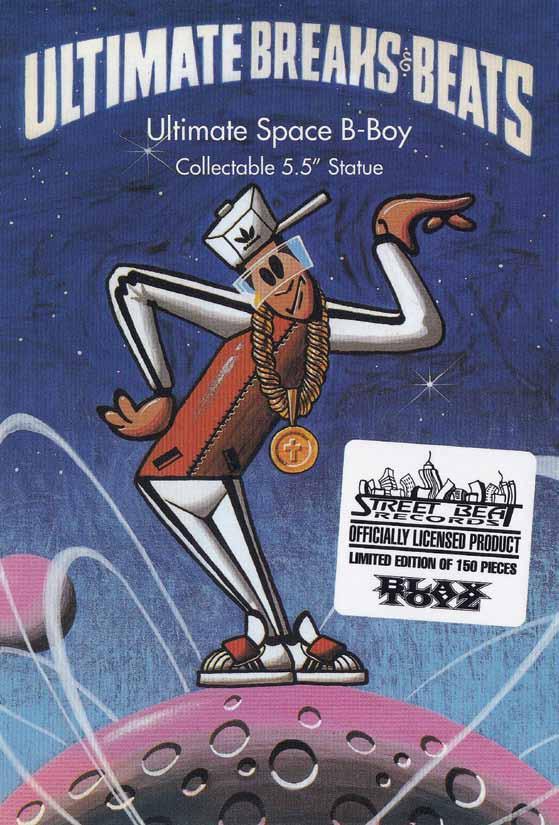
lyrics but I just don’t care, the melody speaks to me and I love the drums by Shuichi « Ponta » Murakami. Tatsuro’s biggest selling hit is « Christmas Eve » so I guess he must be some sort of Mariah Carey out there. In 2018 Dan Tanda released an unofficial mashup called MF
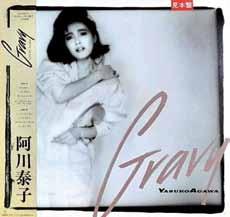
Doom x Tatsuro Yamashita. In the same vein comes « LA Night » from Japanese jazz singer Yasuko Agawa’s 1984 album Gravy. This funky gem was co-written and arranged by Augie Johnson of the band Side Effect, famous for their covers of « Always There » and « Georgy Porgy » (but not only). Great vibraphone by Victor Feldman who also worked with Milt Jackson, Quincy Jones, Marvin Gaye, Rhythm Heritage… Perfect track

for a night drive along the Pacific coast highway ! And if you wanna cruise at night a little more, try « Midnight Cruisin’ » by Kingo Hamada (1982).
Next stop is YMO. Can’t overlook Yelow Magic Orchestra, the legendary band
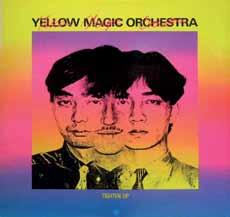
formed in 1978 by Haruomi Hosono (bass), Yukihiro Takahashi (drums) and of course the late great Ryuichi Sakamoto (keyboards) who is most remembered for Furyo aka Merry Christmas, Mr. Lawrence.
Originally a studio project, YMO soon became a successful touring band that pioneered electronic music under the influence of Kraftwerk and Giorgio Moroder. Instead of the huge « Firecracker » (sometimes confused with its intro « Computer Game ») selected by Kurtis Mantronik for his compilation That’s My Beat (Soul Jazz Records, 2002), I’d rather pick the uptempo « Rydeen » from their second LP Solid State Survivor (1979). Let’s add « Clash (Chinjyu Of Sun) » by Logic System, the musical project of Hideki Matsutake who was the sequencer programmer and modular synthesizer
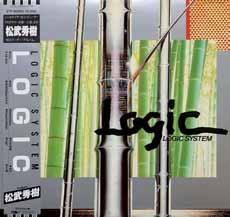
operator for YMO. He was known as the fourth member of the group, worked on several of their albums and toured with his huge collection of synths. He also did sequencing work for numerous technopop albums for other artists in the early 80s.

Time for a b-boy stance with Nujabes and his 2003 « Horn in The Middle » who sampled the 1963 « Joshua » by Miles Davis. Nujabes aka Seba Jun (backwards) was a Japanese DJ and producer renowned for his laidback beats and melodies that often evoke soul-searching and relaxation. Born on the same day as J Dilla, both gone too soon. As Adam Douglas wrote for Musictech : « He was a crate digger first and foremost, and did own two record stores. It’s easy to imagine him spending his afternoons in the records stores of Shibuya and nearby Shinjuku, searching for bottled magic to release from locked grooves. But more than just finding obscure records to sample, he had an ear for melody, for the most emotional bits of a track to use in his compositions… » I’ve discovered Nujabes thanks to Pierre our sound engineer at the time, who played « Blessing It » while we b-boys were warming up on stage. Since then tracks like « Beat Laments The World » from Metaphorcial Music LP (2003) or « Feather » from Modal Soul LP (2005) have been on heavy rotation. Available on YouTube, check this moving tribute to Nujabes by the fourman band OMA from Manchester playing « Luv(sic) pt.3 » live with the original MC Shing02. The Legacy lives on.

There are so many hip-hop ambassadors of Japan like DJ Krush, Muro, Nigo, Rhymester or DJ Honda whose 1998 track « Travellin’ Man » featuring Mos Def makes me travel most definitely. By the way, one of my favorites from Mos Def now Yasiin Bey is « Cream of the Planet » produced by Ski Beats in 2010. Faultless sample from Black Heat « Send My Lover Back » and effortless rhymes from one of the best. Unfortunately only the instrumental is available on Ski’s album 24 Hour Karate School… but there’s a beautiful B&W video on Youtube with the vocal edit (don’t miss the Billie Jean hint). Back to Japan with Kei Kobayashi & DJ Vanne for their 2005 mash-up tribute to « It’s Just Begun » by the Jimmy Castor Bunch… add live covers of « The Mexican » by QASB & Ryuhei The Man (2012) and « Apache » by Stepak

Takraw (2020) and you get a « house of the rising funk » version of hip-hop’s early trinity.
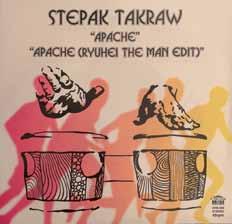
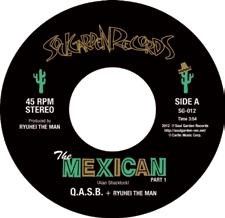
Japan and hip-hop go way back, back to 1983 when the movie Wild Style introduced hip-hop culture to Japanese audiences. When I think of Wild Style, the first image that comes to my mind is the kitchen scene with Flash and Freddy while Lee is painting the amphitheater and Rock Steady carrying a rolled linoleum. Can’t get enough of Ken Swift dancing with a large beanie on his head… I guess I became an addict right away, never went to rehab. Charlie Ahearn explained in his book Wild Style The Sampler that the film premiered in Japan in 1983 thanks to « Fran and Kaz Kuzui who convinced Daiei, the distributor of Kurosawa movies, to bring this unknown independent movie to Japanese screens months before it opened in NYC (…) Kaz was ready to do anything. A Wild Style book ? He made two, crammed with Japanese characters
and every hip-hop image he could get his hands on, all in a space of a few weeks. »
Kaz Kuzui’s first scrapbook is just called Wild Style, it’s both a 70-page color booklet with original cut & paste artwork and a self-recorded cassette. As described by Sotheby’s (estimate 2,000 and 3,000 USD in 2023) : « Containing selections from the soundtrack for Charlie Ahearn’s 1983 film Wild Style, the present lot is the film’s cassette book designed by Japanese artists Kaz Kuzui and Shun Hisamatsu in 1983. With the original Japanese-language obi and 62 pages of color collage, photograph, newspaper clippings documenting hip-hop’s second decade, this cassette book is a celebration of the culture behind the genre’s first entrée into the world of cinema. A promotional object tied to the release of the film, this main art split across the front and back of the cassette book is the iconic Wild Style mural designed by zephyr, Revolt, and Sharp. In a testament to not only the enduring impact of Ahearn’s film, but also the creative work of all the designers and artists behind it, this cassette book on offer here is the inspiration for the NYPL’s limited edition Hip-Hop 50 library card. » His second one is called Wild Style! A Message From New York Ghetto South Bronx. As described by Harper’s: « Tokyo: JICC, 1983. First Edition. Small quarto. Japanese publication documenting the cultural context and background for Charlie Ahearn’s 1981 hip-hop film Wild Style, which was released in Japan in 1983. Thoroughly illustrated, with sections on graffiti (including photos from Fun Gallery exhibitions), break-dancing, street fashion, and DJs/ MCs. Most text in Japanese, with a few English-language translations, including a statement from Ahearn. »
Not an easy find but you need these twin books reunited in your collection if you love to hear the story again and again, of how it all got started way back when.
I’ve never been to Japan and I don’t know much about it. This appetizer can’t do justice to such a unique folklore and rich history but at least it makes me wanna travel with my wife and kids, meet and learn. May be for the next Red Bull

BC One world final in Tokyo ? Dunno but I understand that my attraction to JPN, far from its ancestral tradition, is actually driven by global pop culture. Cause our unperfect world is deeply influenced by the American dream factory, from jazz to hip hop or Apple to Hollywood. It’s built on free trade and mutual benefits so in these uncertain times of protectionism, let’s remember the German band Alphaville who used to sing « Things are easy when you’re big in Japan. »
Guillaume aka Wildstyle Guy IG : wildstyleguy_collection
The R z A - Opening Theme (Raise Your Sword instrumental)
Yuji Ohno & Galaxy - Far Away From The Glittering Galaxy (aka Beyond The Shining Galaxy)
Akira Ifukube - Main Title (aka Godzilla Main Theme)
Cindy - You And I
Tatsuro Yamashita - Dancer
Yasuko Agawa - LA Night
Kingo Hamada - Midnight Cruisin’
Yellow Magic Orchestra - Rydeen
Logic System - Clash (Chiniyu Of Sun)
Nujabes - Horn In The Middle
DJ Honda - Travellin’ Man feat. Mos Def
Kei Kobayashi - It’s Just Began In Africa / DJ Vanne - It’s Just Machinegun
QASB & Ryhuei The Man - The Mexican Stepak Takraw - Apache (Ryuhei The Man edit)

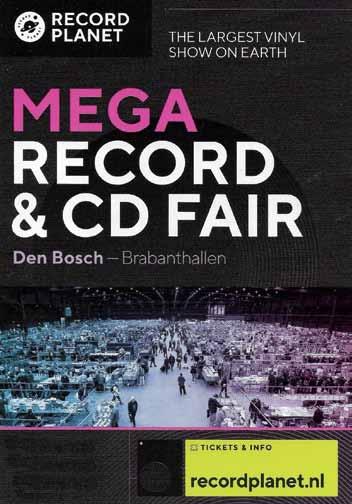

Waddup cats? FIrst of all, well done on getting your hands on a copy of Hot Stuff magazine! The Rambo Boy$ feel that physical product is a rare but necessary thing in these highly digitalized times. Sometimes feeling, smelling and touching just adds to the enjoyment. But back to the matter at hand. We are Eelco5000 and Lovebug Bartski also known as the Rambo Boy$. We’ve been buying records and DJ-ing for more than 25 years. You might know us from playing in the clubs in Amsterdam and occasional gigs around the country. Or you might know us from our radio shows that we used to do at the infamous Red Light Radio and currently at Echoobox Radio. But chances are, offcourse, that you’ve not heard of usat all. No big thing, we’ll sort that out. We figure we can divide the readers of this article roughly into three groups:
1- You’ve never heard of the the Rambo Boy$. In this case what you are about to see and read will give you a global idea of what to expect during one of our shows.
2 - You’ve heard about us and listened to us at some point, perhaps even enjoyed it, but are not clear about what we really are about. This piece will give you more insight into Rambo Boy$ music and art appreciation.
3- You’ve been down with us during the 25-30 years of our dj careers and listen to us regularly.
If that’s the case then you will know what to expect, kind of…
So all that’s now left for you to do is find a comfortable spot, perhaps a beverage and snack of choice, relax and take in all the Rambo Boy$ Science. Personally we recommend reading this whilst on a toilet stool rap break during work hours as this will: A- save you time slaving at the job and: B - Enhance any working experience on multiple levels.
Lastly, before the science kicks in, a big shout out to Twann for taking the pictures and Cafe De Oosterling in Amsterdam for letting us pose with our records and serving fresh drinks.

1. various a rtists – street sounds Hip Hop 19 -1987 street sounds Lll LLL
There’s a pretty big chance that if you were getting into Hip Hop during the mid eighties in the Netherlands that the Street Sounds Electro series was a big part of your musical diet back then and that it introduced you to a lot of great music. It definitely did for me. The first one I ever heard was Electro 10 when i was about 10 or 11 years old and really didn’t know much about Hip Hop besides that it was great. My older brother gave me a tape, or i ‘borrowed’ it, and I thought Electro 10 was an artist that had really long tracks as all joints on this album were mixed to gether so there were no breaks between them. Anyway, I later on found out that it was a compilation album and part of a series so I started hassling my brother to get more tapes cause I also found out he had friends that had the actual LP’s. Science! So for a couple of years I was tripping out on Electro 1 till 17 playing from copied tapes but by the time part 18 came out I had enough pocket money to actually buy it myself. And after that I sor ta managed to save up enough money to buy a copy every time a new one was released. And what was even fresher, from issue 17 they came with superfresh airbrushed graff style covers! The illest to me has always been part 19. Superfresh lettering and a sick robot on the cover. I spent many hours copying the robot until I could do it from memory. I never ma naged to do it at the same level as the sleeve was but I bet I can still do a decent one today. So mad fly artwork but let’s not forget the music cats! BDP, Just Ice, Majestic Productions, Ultramagnetic,Jazzy J & Robbie B and Maggotron all at the top of their game on one LP. Crazy! Did I mention it’s a gatefold sleeve aswell? Extra bonus points! The strange thing is that the first 16 parts of the series had pretty basic artwork just showing the number of the release. Then from 17 up until 20 there were dope graff covers only to return to a basic non graff sleevefor 21.
for 21. And then they finished of the series with part 22 with another dope graff cover! I guess they wanted to end on a dope note. Another weird thing is that 22 is the only part of the series I have never ever seen in real life. More Science and feel free to contact us if you have a spare copy of part 22!!
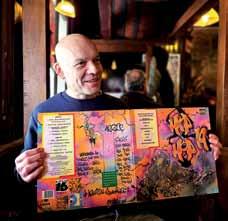
The Crash Crew had been a bit of a mystery to me for quite a while. I heard the name being dropped, I’d seen their name listed in the thank yous and shou touts on the back of rap LP’s but I never heard any of their tracks on the radio, tapes or anywhere. This all changed while I was on a record buying trip in NYC with Eelco5000 and Jasper, who nowa days is the owner of City Records, a fresh record shop which is famous for entertai ning stoned Italian tourists listening to slip mats. We had a big list of record stores to hit and one of them was A-1 records. A-1 was loaded with rap shit including a lot of early 80’s releases. Just what I was looking for at that time so I was stoked to find a Crash Crew 12” in there. It was their ‘On The Radio’ 12, a great joint sorta crossing over from disco rap into the drumcomputer/synthesizer era. The Crash Crew was a five mc and one DJ crew from Harlem who liked to compare themselves to Grandmaster Flash and the
Furious five.
FIrst of all cause Flash and the Furious Five were probably the best and biggest crew in the late 70’s that everybody looked up to but also because they had an identical line up, one dj and 5 mc’s. They also ended up on Sugarhill records just like the Furious Five. In 1984 Sugarhill Records released this album, basically a compila tion of all their 12”s on the label plus one new track, an instrumental called Scrat ching that doesn’t have any cuts in the entire song. Figure that one out. The LP captures more of that ‘On The Radio´ vibe showing signs of where rap would go but still serving a disco rap / live routine style with loads of harmonies. Perhaps it’s an acquired taste but I love that shit. What makes this LP superfresh is the cover where the crew poses on little dirt bikes in the middle of a forest. A great concept but I’m still struggling to find the relation with innerctiy rap music. Perhaps it was team building initiative organized by the label…
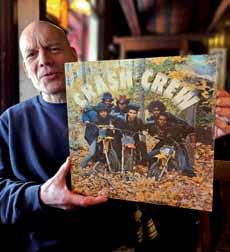
revival that’s currently getting pretty big and super good. But anyway, back then there weren’t many options to hear rare records online. No Youtube, no Spotify or anything like that. So when a record dea ler sent you a sales list in an email or even a printed list in your physical mailbox and you saw titles that you didn’t know but looked like it could be good funk records it was off to Funk45.com to try and find a snippet. I managed to get quite some good stuff by using this method. Also some big fuckups as some records turned out to be complete shit besides that one minute posted on the site. I have to admit that I’d be going through that site about every day just trying to disco ver fresh stuff and add it to my want list and search for it in the early Ebay days. Anyway, I heard the Hunt’s Detemination Band and it blew me away immediately, super hard psychedelic funk spread out over parts 1 and 2. I had to have this 45!

This tune I first heard somewhere in the early 2000’s on a website named Funk45. com. This was a website where a London Deep Funk fanatic was collecting and uploading loads of one minute snippets from all sorts of funky 45s. His name was Andy and he was in a band together with Malcom Catto called the Soul Destroyers. Do the work and google that shit, it was quite fresh and early on in the funk/soul
But back then it was out of my price range so I always kept an eye out and managed to find one about 15 years later. I was su per stoked and was even more so when it arrived. I knew it came with a dope picture sleeve showing the band posing in serious winter conditions next to a fresh ride but when i pulled the record out of the sleeve I saw the crazy label artwork. Two bleeding ears on the sides of the centre! Or could it be red earwax drip ping out as the label is named Earwax? Superfresh whatever the explanation is. Pretty obvious that it made this Rambo Boy$ list. Some more knowledge to be
dropped though. Through writing this piece and doing some research I found out that there are two other releases of this track on Earwax. One on a blue label with regular lettering, no bleeding ears, containing parts 1 and 2 but also a super rare orange one. Also no ears but with a different flip, a really good crossover tune called ‘Are We Through’. Another one ad ded to the want list!
They went on to release some more sin gles and two LP’s, all on Earwax records. The LP’s sound kind of like the Bar Kays did in the late 70’s so decent shit but comple tely unlike this 45 banger.
4. o rchestre Picoby band - Honton ve Zoun -L. a .Ecoutes
This record is somehow related to both the Crash Crew and the Hunt’s Determination Band. I bought this on the same trip to NYthat I bought my first Crash Crew record and it has an ear on the label like the Hunt’s Determination 45. But I must admit, this record made this list mostly because of the impact of the music. The artwork is cool but nothing like the other records in the article. Back when I bought this I didn’t really know much about African music besides a little bit of Fela, Manu Dibango and Geraldo Pino. The last one only cause his 45 Heavy Heavy Heavy got played on the Deepfunk scene in the early 2000’s.
Scratching the surface one could say. But around the time of said record buying trip I had stumbled upon the works of a guy called Voodoo Frank who was compiling loads of West African music on the internet. Frank was coming from the Deepfunk scene but had changed his focus to African music. I was listening as much as I could to the stuff he posted and got really excited by the heavy funk shit it included. And doing some online work I learned that in NYC there was one shop that was known for having a good African section; Good Records NYC. So when we got there I went through the African section and hardly recognized any names. I made a stack of records and listened through them and when I heard the Picoby one it floored me. I left the rest of the records, bagged this one and we went back to our spot. Eellco had brought a portable turntable and the apartment had a pretty decent stereo we could
hook it up to. I told the boys to sit down and open their ears and played the record. We played it 15 more times in a row after that.
We’d never heard anything like this and it went perfectly with a couple of cans of Red Stripe. I was immediately hooked to this sound and still am. Orchestre Picoby hails from Benin, a country you never real ly hear about situated in between Nigeria and Togo in West Africa. Also from Benin is the more famous Orchestre Poly Ry thmo. They released over 50 albums and when they did funk records it resembles the sound of Orchestre Picoby. No won der really, the writer of Honton Ve zoun was Avolonto Honore, also a Poly Rythmo member. There are a few other bands from Benin from that era and most of their stuff I really like so it’s safe to say this 45 triggered a big love for Beninese music!
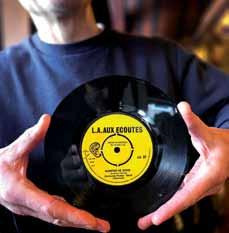
Let’s do this one Edutainment style! The Telstar 1 satellite was the first ever com mercially launched satellite and was paid for by AT&T. Launched in 1962 it was used for phone traffic and tv signals. A fine pro duct to name your band after. At least I assume that’s what they were named after since the album title is Orbiting. Just what satellites do innit? Also having the band pose next to a massive satellite dish for the cover points in that direction right? All this I learned as a result of writing this piece for Hot Stuff. I guess I’m the shallow type record collector that doesn’t really think about artwork that much but just goes for the tunes. I mean,
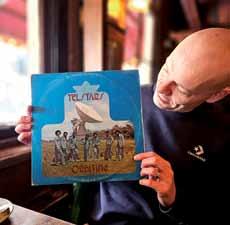
I’ve always loved this sleeve for the com position and seemingly very random lo cation of the photo but I was just sleep ing. It all makes sense and looks great too! Shout out to Mike aswell for tagging up the satellite dish. If you know, you know. There’s also a little story to be told about how I acquired this LP. At one point in my life i was moving house, a good time to look at your belongings and decide what to keep and what to let go. This also ap plied to my record collection. Now I had worked at Fat Beats records for a couple of years and they did distribution for a lot of Hip Hop labels and for most of the re leases from our distribution we received promo copies at the store.. Staff always had first dibs on those freebies so we could get a lot of stuff for free. Those that know me know that during those days, the early 2000’s, I wasn’t really feeling a lot of rap shit coming out so I was trying to apply some quality control and only take stuff I’d really like. It turned out that getting shit for free makes you less picky cause when I was thinning out my record collection I was able to completely fill one of those cardboard moving boxes with Fat Beats promos. I figured my homie Taco at Waxwell records might be intere sted in buying or trading them so I lugged the box overthere and showed him the contents. He said he’d trade it for stuff out of the store.
I saw the Telstars LP and I knew one track on the album called Making A Living. A
supernice mellow funk track that switches into a heavy heavy funk breakdown for the last minute. That was enough for me to offer the box for the LP and the deal was done. The LP has another good funk track and some reggae and even a bal lad but I have to say this one is definitely on the list for superfresh cover. I don’t think at this point I can list more than 5 records of the more than 50 that were in that box and I’ve never felt any regret about this deal. Rambo!
1. b larf - Cease and d esist -2019 stones t hrow records
Wauw.. This record came on my radar when I saw a video from it called Badass, Bullshit, Benjamin,Buttons ,Butthole Assassin; it’s a cut and paste record and a cut and paste video, made from all sorts of weird shit found on the al-mighty internet I guess. Heavy drums and percussion, Dr. Phil worshipping Satan and what not. I was instantly intruiged by it. It’s fun, super hectic but very Rambo, if you are epileptic I suggest to stay away from it. The name Blarf did not ring a bell, but I found out it was released on Stones Throw in 2019, it picked up a copy which was quite difficult at the time, the first batch/press was very limited for some reason and that intrigued me even more. The amount of samples being used here took me back to clearance issues you had when for

example De La Souls 3 Feet album came out. I found out that Blarf was Eric Andre, an American comedian who is actually quite populair. He has a super weird but enjoyable talkshow named “The Eric Andre Show” which is a mixture of Jay Leno, JackAss and Rembo & Rembo.
The whole thing is fun, loud, a bit provocative at times but it resonates great at the Rambo Lab. The whole thing is a big mash up in terms of music, visuals, and what not. Blarf is basically that ugly Mc Donalds clown but even scarier. It inspired me to start doing some video editing myself (honorable mention to Jason Goldwatch for doing “Fork in the Pot” and “Carry the fire” and just make dope video mash ups of stuff to be found on the world wide web. If you look up Eelco5000 on youtube or IG you’ll find some stuff. Now you know where the inspiration came from.
Big Rambo tip, but again, not if you have a weak heart.
2. g loster Williams and Master ControlPraying s pirit -1979 L. a . records

12 years ago I had the privilege to work at Waxwell Records for some time. It was a Saturday I was sitting behind the counter and an English dude walked in. He said, hello, you know KC the Funkaholic? I said offcourse. He said, you know this
record? He showed me the Gloster joint, I believe it was sealed. I said no. Im bringing this to Kees. Cool, I said. He said, look up “No Cross No Crown” on youtube. I did, he said play it loud. Did that too. I liked it, but nothing out of the ordinary in my opinion, just very decent modern gospel soul. He said skip towards the end. I did, this shit is so mindblowing he said, its just the choir singing along with the metronome, listen... It sounded mindblowing indeed. I listened to it several times the week after and came to the conclusion that the metronome was one of the funkiest mistakes I heard in quite a while. At least I presume it was a mistake. After several listens the Rambo meter went through the roof and I had no choice but to come into action.
So offcourse, as we did back in the days I put it in my Ebay search list and got a physical copy 4 cheap not long after. Easier and more affordable times to buy physical product. Great succes.
The guy btw was The Mighty zaf, a super knowledgeable and legendary deejay and nowadays recordstore owner (Love Vinyl, London) but more important, a super nice guy. I believe I speak for both Bart Fader and myself that we always liked the social element in this music/record buying game. No pretentious bull shit for the Rambo Boys. We also talked a bit of Premier League football that day and then he left. Great day at the office!
3. Jay W. King- i ’m so afraid / i don’t have to worry- skyscrapers records
This is a very recent addition to the Eelco5000 RamboLab record shelves and a record that has no special value in terms of a great story.
I mean.. It’s dope, both sides btw, my favorite is “I’m so afraid”. A deep soul beat ballad that blends perfect with the drumless rap production you hear nowadays by the likes of Roc Marciano or Alc for example. A great mixture of genres in my opinion if for example you where booked as a deejay in an illegal casino, striptease joint or bruine kroeg. Tip! The label Skyscraper has one more

release besides this. A Northern Soul shit by Rufus Lumley.
Not bad, but not my taste. The label design for this is straight up Rambo, you cannot go wrong with a city skyline in my opinion. Shoutout Sugar Hill Records, Windy C Records and many more.. So yeah, a 45 that crosses of all the Rambo checkboxes, but more important, its affordable. And thats the point im trying to make with this record. Buying records became a thing for those with deep wallets the last couple of years. Always has been offcourse but it skyrocketed in recent years. I understand that ever since Storage Wars & Pawn Shop combined with the internet became big players everyone and their momma got the feeling that they are sitting on gold. But its not true you capitalists!
So, I would like to tell all recordslangers that overprice every mediocore record that has great potential at 5 bucks, but sucks at 25 that they can get the bozack.. Just stop, its depressing.. But offcourse a honorable mention to all recordpushers that keep it fair and fun. Rambo Boys salute you, and appreciate you, we see you, and we love you. We komen snel weer een bakkie doen.
Shoutout Waxwell Records, City Records,
Recordfriend, Rush Hour and everyone else I forgot.
4. Mungu Mtoto - g hetto Children-1984 g hetto tears tecords
With growing older also comes change in musical taste. I mean, I always liked reggae, my wife has a serious collection of compact discs. So every sundaymorning breakfast we have something nice to play from the island of Jamaica. And that was enough for me. I always tried not to buy reggae records, but you guessed it. I failed miserably. Which brings me to the record at hand. Mungu Mtoto beter known as Winston Thompson and/or Dr. Alimantado, with his underground smash hit Ghetto Children, released independently on Ghetto Tears in 1984. The only thing he ever did under this name. I heard this on a mix many moons ago, but I don’t shazaam so I just

decided to enjoy it. Years later my friend Jasper of City Records offered me a few records, and this was one of them. The air got sucked out of the Rambo Lab when I found out what it was. I said, say less brethren... I’ll have it. I had the pleasure to play this a few times on a decent soundsystem and believe
me, this is that powerful stuff with an im portant but unfortunately very sad message that always needs to be heard. Fuck social injustice all day everyday. The artwork and label design are straight up mental. This thing is a true gem. As a matter of fact.. This record is so Rambo, for those listening to us on Echoboxyou might have heard this multiple times already. I try to play fresh “new” stuff every show. But made an exception for this.
Now you know. I like it even more after 2 glasses of Captain Morgan.
5. s howb iz & ag - Party g roove / soul Clap-1992 London records
Rambo Boys are rapfiends like that song by Ray Love. We consider ourselves students of the game, or at least I do. The ultimate beats and breaks era, protorap era, discorap, eigties rap, the golden era, the twothousands whatever we always have our ears open to the freshest shit. We consumed all the “thank you” lists, liner notes you could find on records, tapes and ceedees like crackfiends, the magazines back in the days, the scarce amount of actual footage we could get our hands on.
And nowadays podcasts, socials you name it, it never really stops. All for the love and fun of it. Nothing more nothing less. I remember my mother once said that if I learned in school like i learned the lyric sheets of the second Public Enemy album I would be a doctor or whatnot. I said f.. being a doctor, I want to be Proffesor Griff..

Anyway the point im trying to make is that hiphop means the world to the Rambo Boys, and although I enjoy a lot of new and other shit nowadays. If you ask me where my love in hiphop is the purest or most unconditional i’d have to say the nineties. I consider it my save haven where I can return 2 whenever I need to.. i call it home. This Showbiz & AG record has it all, plus it came out in 91, which I mark the unofficial beginning of the nineties era. Why not? First released indpendently on ShowBiz Records of which I own the repress too. Giant in the mental, Party Groove, Diggin’ In The Crates, all mindblowing shit I got to witness when it came out as I youngster. Forever grateful for that. These joints resonated like nothing else as a lil Rambo Boy. So powerfull. So fresh, So dope, So Rambo pffff..
ARTICLE by ANDREAS HELLINGH
AmSTERDAm
One of the hottest and most stylish new R&B, Soul releases that came out in the batch of Autumn 2008 was without a doubt Peggi Blu’s thoroughly credible “Livin On Love” album, her 3rd and most

impressive release since her debut in 1980 featuring the penned Nick Martinelli & Alex Brown “I Can’t Wait” The European club anthem “Can’t Go Back” and personal favourite’s “Livin On Love” and “Uh Oh” to name a few.
By the time you have read what this singer/performer/actor/American Idol vocal coach has accomplished in her lifetime you will agree with me that she’s Gods best kept secret.
In a previous radio interview I asked Miss. Blu and husband/musical partner Ted Perlman why it took 15 years in between albums and before she could explain Ted answered, “At the time I was busy recording and producing for many other established artists and pushed forward my wife’s project. Peggi have forever asked me to finish the “Livin On Love” project and I owe Peggi my sincere apologies, I am the reason why it took this long, not my wife, I promise you this….
You won’t have to wait another 15 years before she returns with a new album, he laughed!”.
Peggi was born in Lumberton, North Carolina (near Fort Brag, one of the Army bases in North Carolina), and grew up there until she was 14. She was the only daughter to James and Avis Blue “I come from a very prominent family she explained, a family of Ministers, lawyers, doctors. My cousin works for the North Carolina State Senate, she’s a State Senator!”. Peggi continued; “My mom was a singer and used to be a quire directress for many different churches. My dad, James Blue died when I was very young”. Peggi was religious and extremely spiritual, an ex Kojak (A domination called church god & Christ) which is how she grew up.
At the age of 3 she was taught to sing her first song. “Yeah, my granddad taught me several songs, one of them was “When My Role Is Called Up Yonder” however I couldn’t pronounce the letter R so I sang Yole instead of Role, another song my granddad taught me was “I’ll Be There” and “I Wanna Go To Heaven And Rest” Peggi started singing…. “Down here I’ve done my best – I’ve had my trails and stood my test and I wanna go to heaven and rest…”.
By the time she was 9 years old she was already a professional singer because she travelled extensively all over North Carolina, Virginia singing with her cousins in a group and quire. At one of those occasions in church Peggi got acquainted with The Nat Lewis Singers who had come to her town to sing and do a concert. The arranger of the group heard Peggi’s performances and told her; Girl if you ever come to New York you’ve got a job, I will hire you on the spot!! She kept in close contact with Nat Lewis and after
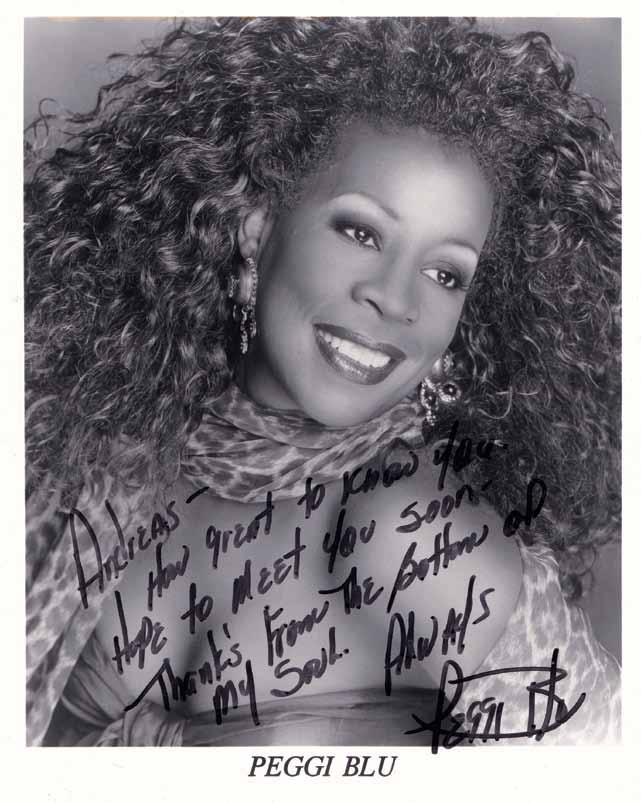
aprox 18 month she received a phone call from Nat who told her that one of the members left the group and if she still wanted the job it was her’s. “My mom was not a happy camper… but realized that this kid is going to run away if I don’t let her, if I don’t sanction it she’s going to leave me anyway. They set me up to meet my uncle in Virginia, it was his convention, his church “the rose of Sharon god and Christ”, and they were having their annual convention in North walk I think it was… No, Richmond, Richmond, Virginia and they send me there to meet my uncle and he took me on to New York. As soon as I got to the Big Apple I called Nat and said; hey I’m here, when is the rehearsal? The Nat Lewis Singers was just about to open a play called “Sweet Chariot” and Nat said I need that second girl so I landed the job. However I was so young so one of my managers at the time Joe Scandori had to lie, infect they all lied and said I was 18 but Nat didn’t believed them and told them to get me some working papers because I was under age so arrangements were made, papers were issued and I joined the group”. Peggi stayed with the Nat Lewis

Singers for aprox 4 years and toured with them all across the United States.
Blu got her education at The Lumberton Catholic School, South Lumberton Elementary School, Hilly High and received her final degree while on tour. Shortly after the Nat Lewis Singers disbanded she joined the Humble Gospel Singers for a short period of time. She then joined the Gospel Starlets, a gospel group with a huge following who released several records such as “I’m A Worker For the Lord”, “One Day I’ll Wake Up In Glory”,” On My
Knees Praying” and “Children Go Where I Send Thee” to name a few. The group worked a lot with James Cleveland & The Caravans, The Dixie Humming Birds and many other gospel groups and quartets. “I stayed with The Gospel Starlets for aprox 5 years, an incredible experience which taught me a lot. I loved the Gospel Starlets, they were a bunch of sisters and the manager of the group Miss. Charity Faison became like a second mom, Charity’s daughters, Ernstine, Dorothy, Gladys and Mary where like my sisters I never had, and we, a matter of fact Mary and I ended up singing together with Stephanie Mills and then Mary would sing background with me for my shows and out of that union came John Simmons as well. John was the keyboardist in the Gospel Starlets and as it turned around some 15 years later he became Stephanie Mills’s conductor and Mary and I where Stephanie’s background singers, so it was like having my sister and brother with me, we were that close! - I’ve done pretty much what god has told me to do. I am religious but more spiritual which people hear when I’m on stage. But I would never go; God, God, God. My soul aim is to touch and reach people, music is a healing thing and that to me is very spiritual. I believe it heals your soul whether you sing Baby, Baby or Jesus Christ, you can be touched either way”.
Peggi Blu would soon then join the gospel outfit, The Patterson Singers led by the late Robert Patterson, which was an international group that toured around the world including Germany where the group performed a lot. The Patterson Singers recorded for labels such as Atco, and Gotham Records, “The Cry Of My People” is one of the records, which features Miss. Peggi on lead on one of the songs. She stayed with that group for about 2 years before she became a Sand Pebble. The Sand Pebbles was a recording group, led and owned by Teddy Vann, who deserves credit for “Never My Love” from 1968 and “Love Power” witch ranked #22 in 1967. “My girlfriend Louise called me up one day and said how would you feel to become a Sand Pebble? – I responded…. “Have you lost your mind? You have to be crazy!” She said, look they are down 2 singers and they have a date 1 week at the Apollo Theatre, and I was like Wooooow, and you are calling me? Louise is the girl who
I called to replace me in The Humble Gospel Singers so she was turning it back to me and said meet me at this place in Manhattan and I’ll introduce you and we’ll sing. So we did and we destroyed the place. They loved us and we before I realized, Louise, Michelle Stringer and I became the Sand Pebbles”.
Peggi Blu stayed with The Sand Pebbles for only 1 year. Teddy Vann had lost his deal with the Record Company because it went under. By that time Peggi had toured extensively and during the beginning of the 70’s the whole Music Industry had changed from where on she went to sing a lot of background sessions. Peggi Blu who is an excellent support singer can hear harmony’s upside of walls and back. Carl Hall (Lead singer of the legendary gospel group “The Raymond Rasberry Singers”) was the person who taught Peggi to become a background singer “Yeah, I met Carl Hall in ’71 or was it in 1969? I can’t remember but he taught me how to stand in front of a microphone in the studio because you know it’s different when you sing live or go and do a record. You use separate kind of muscles, it’s a whole different training, so he took me in and started teaching me doing that, he believed in me and sometimes he would yell at me and say; No don’t breath that way you’re going to run out of air, breath with your mouth open, Peggi laughters, Carl used to take me, Tasha Thomas and other singers to sing background for a lot of different artists including Esther Philips, we we’re like brothers.”
Blu took an absence of 5 years from the recording industry because she needed to get out of a contract witch she couldn’t get released from. Back home in Brooklyn, New York she went on to sing at Churches and gave vocal lessons to various singers. In 1974 she became a member of the popular R&B group The Crystals who placed six songs in the top twenty in 1962 and 1963 and helped to set the stage for other acts that would follow for their producer, Phil Spector. They helped Spector to establish his famous “Wall Of Sound.” The group came from New York City and was formed during the time Spector spent working in New York City’s Brill Building. They consisted of original lead singer Barbara
Alston, Dee Dee Kennibrew, Patsy Wright, and Myrna Gerrard; others at various times including Delores “LaLa” Brooks, Mary Thomas, Frances Collins, Darlene Love and Peggi Blu.
In 1963 they recorded “Da Doo Ron Ron (When He Walked Me Home)” other hits that topped the charts where “There’s No Other (Like My Baby)”, “He Hit Me (But It Felt Like A Kiss) to name a few.
“One day my girlfriend Liouse called me up and said, “Hey what are you doing?” I said why, I’m cooking dinner what do you want? She said are you ready to get your lazy bones up and get back to work? Peggi laughs… She gave me the address to Dee Dee Kennibrew’s house and continued, meet me at rehearsal at 7:30, I said don’t you mean an audition? Her voice got harder, No meet me at rehearsal, I’ve already told them, told who? Dee Dee of The Crystals, she screamed!! Peggi starts laughing again…”
That night she went to audition and for the first time got acquainted with Ted Perlman who she would married one year later in 1975. Ted was there to audition as the Musical Director for The Crystals. Perlman had just come from overseas working with Harry Belafonte

and both got hired on the spot! Peggi Blu stayed with The Crystals for 2 years and toured all across the United States, Australia and the UK where they had just re-released the hit single “Da Doo Ron Ron” witch peaked #4 on the charts. As a Crystal she shared stage with Jackie Wilson, Little Richard, Benny King and The Coasters to name a few. “Ted is a wonderful man, we used to arrange songs for our live shows. After we were no longer Crystals, we started doing arrangements for other people live shows as well as records. One thing led to another and we set up a company called “Perlman Blu Arrangements”, which branched off into making records. I love when he arranges music for me because he does it with all the love he can muster, which in my book is immeasurable. As for writing. We simply would sit down sometimes to do something else and a song would pop out, or in some cases we would just have finished a session for someone else and Ted would say “Hey Peggi, listen to this music that I came up - with do you like it?” Or he’d say “I wrote this for youdo you like it?” - and it would be perfect. You see he did it all with me in mind”
When L. Frank Baum wrote his immortal fantasy “The Wonderful Wizard of Oz” in 1900, it’s doubtful that even he had any comprehension of the timeless universality his delightful story possessed. In 1903 a musical adaption of the book “The Wizard of Oz” opened at the Majestic theatre in New York and ran for 18 month. The “Wiz” is still one of the most successful Broadway Musicals of all time. In the all-black National and Broadway cast it featured Peggi Blu in the roles of “Auntie Em” and “Glinda the Good Witch” alongside Stephanie Mills as “Dorothy”, Carl Hall as “Wiz” and Jasmine Guy as the “Crow”, and “Kalidah”. It also starred singer Ada Dyer, previously known as Miss Adaritha in the roles as “Munchkin” and “Chief of the Field Mice” The original cast recording of “The Wiz” was produced by Jerry Wexler and issued by Atlantic Records in the spring of 1975. Curiously, when “The Wiz” was made into a full-length feature film by Motown Records’ film division and Universal Pictures. Theresa Merritt played the role of “Aunt Em” and Lena Horne as “Glinda
the Good Witch” instead of Peggi Blu. Stephanie Mills was replaced by Diana Ross and it’s needless to say audiences didn’t buy Lena as the lovable “Glinda the Good Witch” and the film ended up being a major flop. During nights when Peggi finished “Whizzing” she often went to see and share stage with other musicians at different Nightclubs. Peggi Blu “Wiz zed” for 2,5 years and continued in Regional and off-Broadway Theatre Productions such as “Marilyn, An American Fable” where she played the role as “Miss Destiny” (Marilyn Monroe’s alter-ego), “Beehive” long side Jasmine Guy and “Apollo, Just Like Magic” (1981) Which was Directed by George Faison, who was also the Choreographer for the “Wiz”.
“You know what If this had ever been blessed to Broadway, I know it would’ve been a monstures hit! Because we were re-living what happened in the early days of the Apollo and some of the

groups, artists, comedians and dancersMorgan Freeman who is this huge movie star now a days was with me, a lot of the people who featured in this play became big stars - We had a good time, all of us!” Peggi explained.
After Miss. Blu’s performances at Theatre she received a phone call from her friend the late Carl Hall who told her that a friend of his named Jerry Ragavoy was looking for a singer to record his music. Jerry Ragavoy, a songwriter/producer from Philadelphia, Pennsylvania who worked with some of the biggest names
at that time, Irma Thomas, Lorraine Ellison, Major Harris, Janis Joplin, Dionne Warwick and who’s music is still played today! Carl passed on Jerry’s number and Peggi went to meet him that day after and a musical friendship was born. Out of this friendship came Peggi Blu’s solo debut album “I Got Love” on MCA 1980. Jerry Ragavoy wrote and produced the album. From that album MCA released 2 single’s “Dancing On The Streets” which reached #35 on Billboard’s dance music chart and the title song “I Got Love” which first appeared in a 5:42 mix on a white label DJ promo with on the b-side “Dancing On The Streets” with Ted Perlman on Guitars and Howard King on Bass. “I Got Love” was also featured in the ABC movie “Off The Minnesota Strip” (starring Hal Holbrook). The album never received the fame it deserved because it was more a Disco album and in 1980 Disco was on its way out – During the making of “I Got Love” Ted Perlman told Jerry Ragavoy to change and replace some of the materials because he felt they would not stand the test of time. Jerry ignored Ted’s advice because he was clear about his vision but not ready for the changeover. None the less the album opened Miss Blu a lot of doors and it sold more copies then they first imagined. It also secured her future as an artist and the possibility to perform at several big concerts such as one in Montreal when she sang in front of 55.000 people and at “Super Fest” for 50.000 hungry soul fans alongside The Manhattans, Phyllis Hyman, Luther Vandross, Patti Labelle, The Commodores.
During the release of “I Got Love” Peggi continued to work as a session singer and gave vocal lessons to singers who later would become superstars. “Yeah, during my deal with MCA I continued working as a session singer and I remember when Irene Cara called me up one day and said, “Peggi I need your help, can you teach me? I told Irene to drop by my house here in New Jersey and I gave her a few vocal lessons and she got her self a hit with “Fame” which also featured me and Luther Vandross on background vocals”
In 1986 Peggi Blu got her biggest break yet. Her agent submitted her to the famed
TV show “Star Search” after only four shows she won $100.000,00 in prize money as “Grand Championship Female Vocalist”. At “Star Search” she sang Peabo Bryson’s “Feel The Fire”, “Giving Up Is Hard To Do” an old Donny Hathaway song and Aretha Franklin’s show stopper “Do Right Woman, Do Right Man” with new arrangements by Ted Perlman. Peggi was asked to sing that song twice and it killed the audience! “Star Search” was the world’s greatest talent competition show ever witch ran for 12 seasons from 1983 till 1995 when America officially ran out of talent. Many of today’s favourite comedians, actors, supermodels and singers came from “Star Search”, like Sinbad, Sawyer Brown and Britney Spears.
“Oooh, “Star Search” Peggi laughsWhen I first auditioned I didn’t get it because Ted and I had a Rock band and there were no slots, all the slots where filled. But the second time I got submitted I would fly in and out New York to Los Angeles and do the show - At that time I was still acting and I didn’t told anyone that I was on “Star Search” because if I would lose nobody would know, and everybody would be shocked including me, Peggi laughs. – I was the last one to come on stage, I asked God to give it to me. On our way in the airplane to “Star Search I said to my husband, Honey I want it all – and he said what? I said I want the 100.000.00 Dollars - And he said are you crazy? He said I believe you can get it but are you sure? And I said to god I want the last thing to be heard at the end of the “Star Search” season, I want the last voice

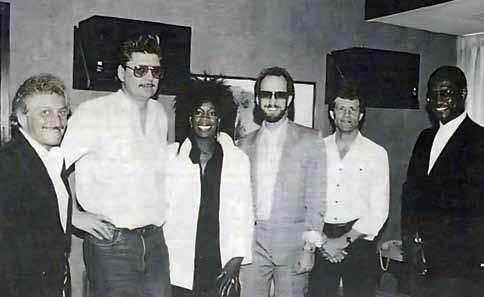
to be heard to be my voice because it would stay in mind to the listeners. And when it came back on, at the beginning of the season, which mends I had one more performance and I wanted the first thing they heard to be me and I got it. I got exactly what I prayed for! “Star Search was huge… It came on national TV (CBS /Channel 2) twice a week and I had friends calling me from Germany, Hawaii telling me; we just saw you on TV, amazing! During that time I met a lot of nice people, they put us up in nice hotels, they made it very comfortable for all of us and it was a good thing for me because I won – With that money I won we were able to open our own studio and I put Christopher Perlman, my son to collage and do a lot of other things, actually a lot of nice things, Laughs Peggi.
Out of a result from “Star Search” came Peggi’s 2nd album for Capitol Records. One of the judge’s that night was Wayne Edwards, Vice President of Capitol Records black A&R division who had asked Peggi to meet and to discuss a possible record deal. That same week, during a conversation between Nick Ashford and Valerie Simpson he was recommended to sign a deal with Peggi, which he did and Capitol put together a budget of
$500.000.00 dollars to record the album. During that time Peggi had changed her last name from Blue to Blu. In the middle of the production phase of “Blu Blowin” Peggi feared that her album would not be put out and shelved like so many others that time because Capitol was going thru numerous restructuring and management team changes. Her prayers got heard again and after 12 month of hard work Capitol released what was to become a hit record in Europe! Unfortunately due to these management changes the label was unable to promote the “Blu Blowin” project and Peggi received an official apology from the Executive of Capitol Records telling her that they blew it because at the time they didn’t knew they had a hit record! Despite the failure of massive sales in the U.S.A it sold extremely well in Europe, especially in the UK where the album reached as high #4 on the club charts. It also received critical reviews in Billboard, New York Post, USA Today and it led to TV appearances in Entertainment Tonight and Good morning America. The “Blu Blowin” album yielded 2 singles; first the Nick Martinelli produced “Tender Moments” which ranked #28 on Billboards R&B charts and “All The Way With You”, a duet with Bert Robinson who was just signed to Capitol Records. Peggi and
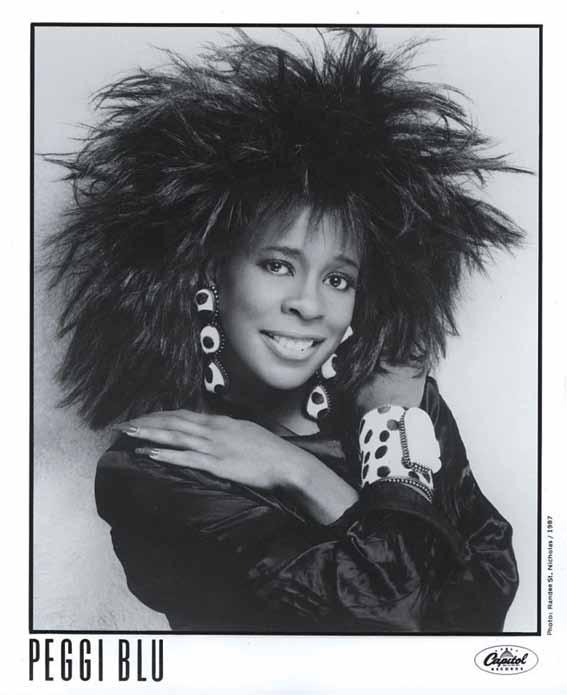
Bert never met each other and officially the label would release the song “All The Way With You” as a standalone song but Capitol made a business decision and Bert’s vocals where added to Peggi’s. The album also featured a lot of other possible singles such as the previously written and recorded Isley Brother’s classic “Once Had Your Love” the stunning “Over And Over” and the dancer “Love’s Just A Mystery”.
After the release of a major record usually any artist would take a brake and enjoy success, but not Ms Blu… Instead she opened her own studio which she had just finished building and continued acting and do session work at the same time for artists Including; Leonard Cohen, Tracy Chapman, The Crusaders, Brian Setzer, Barbara Streisand, Bob Dylan, Cherrelle, Quincy Jones and a host of others.
Moving forward to the beginning of 90s it should not be left untold that Peggi Blu had little feelings to release another song or album because she felt the music industry had changed extensively and by that time very few labels where interested in quality singers or materials! One day, David Nathan a respected freelance journalist from the US stopped by Peggi and Ted’s studio in L.A while they were playing around with a demo Ted had just written called “Love Is The Magic” Nathan loved what he heard and told Peggi to send the song to Ralph Tee from Expansion Records in the UK. At that time Peggi was still convinced that nobody would have an interested in such type of materials and told Nathan to forget about it but eventually agreed and Nathan contacted Ralph and a few month later the song ended up on a compilation called “Soul Sauce Volume 1”. The song itself became a huge hit and peaked #9 on the R&B chart in the UK During the years Ted and Ralph kept in close contact and the demand for another Blu album began to grow. “When I found out “Love is the magic” was so well received my heart began to make overtime… Laughter’s Peggi “I wanted to record another album but I was still n the middle of so many other great things and I would try to record new songs as often as I could but often I was not satisfied and ask Ted to re-write and recorded the songs we just recorded. He wasn’t happy about it” Peggi laughs again “If I was
about to release another record I wanted it to be something special, something I would feel happy about”.
In 1997 Peggi received a phone call from Larry Hart who she knew from a benifition concert and previous theatre productions. Larry had just written a musical “Sisterella” a revision of “Cinderella” and asked if she would like to star in his production. Peggi accepted immediately - that same day she received the script and a month later she played the role as “Dahlia, the Wicked Step Mother” and toured for 4-month all across Germany and Austria. A single from that show featuring Peggi was released by MJJ/Sony in Europe - “I Got The Money”. In February of 1998 she returned to Germany to costar with Linda Hopkins in a revue “Wild Women Blues”.
If only I could turn back time, change roles and be Peggi for just one moment, what a performance, what an achievement. Gosh, I haven’t even talked about her work with Barbara Streisand, Philip Bailey, Phil Spector, The Manhattans, Burt Bacharach, The Wheater Girls, Smokie Robinson, Iyanla Van zandt, Aaron Neville, Arif Mardin, Phyllis Hyman, the list of names she worked with is endless.
Peggi Blu was never a household name but very much loved among her peers in the music industry. Blu passed away in Los Angeles at the age of 77.
Rest In Peace
Peggi Blu
May 26, 1946 - May 19, 2024


In 1970s Portland, a band of teenagers set out to develop a sophisticated take on the fusion sound. With moral support from the community and a rock solid practice routine, Pleasure gained the endorsement of luminaries such as Earth, Wind & Fire and Kool & The Gang. Through the mentorship of Wayne Henderson, a deal with Fantasy Records soon followed. Across six LPs in nearly as many years, the group’s influence is evident in samples from artists such as Daft Punk, Janet Jackson, and Sugarhill Gang. In conversation with bandleader Marlon McClain, we explore the band’s come up, accolades, and and creative process.
Interview with Marlon McClain
Conducted by Bobby Smith
Let’s take it from the top. you grew up in Portland, right?
Marlon McClain: Yeah, Portland was a great city to grow up in. It was the kind of place where you felt comfortable moving around. My family was on 10th & Alberta St. I was always listening to the radio and that’s what originally got me into wanting to play guitar - just listening to radio and hearing guitar. I convinced my mother to give me a guitar for Christmas so she bought one at Woolworth’s. I had a Woolworth guitar.
o h, wow. Woolworth was way back when.
MM: Exactly. I got the guitar and most everyone in Pleasure lived in that neighborhood: myself, Nathaniel Phillips and Doug Lewis…we were all friends from Highland Elementary [currently Martin Luther King, Jr. Elementary]. They got guitars, too, and we would go back and forth to each other’s houses and listen to records. We would listen and try to figure out the guitar parts. That’s how we really learned to play.
MM: There were a few: Jimmy Hendrix, The Meters, Dyke & The Blazers, and definitely James Brown. We also learned from people in the community. There was a guy named Ural Thomas who encouraged musicians and gave them tips. He always had these jam sessions over at his house off Mississippi Ave. You would go up there and that’s where you really cut your teeth - from being around musicians that were better than you.


t hat’s beautiful. Pleasure also had a pretty strong jazz inclination. d id you study jazz?
MM: We found jazz but that happened much later. In the early days it was mostly hearing what was on the radio. Later we started expanding our consciousness and got more into listening to stuff like Miles Davis, Mahavishnu Orchestra, and Billy Cobham.
But we were always in the basement practicing - getting our chops together. Bruce Carter’s parents were so supportive. They would let us practice at his house all the time. We would spend the night over there. His mom would cook us breakfast and we would just go back down to the basement and practice. It was the best environment.
And this became your first group, Franchise?
MM: Correct. We were a small group with organ, guitar, bass, and drums. We were really into Sly and The Family Stone so we played a lot of their music. It was all about the rhythm of those songs. We played a lot of songs like that.
s ly had a bay area connection, right? i know the Load stone label where he started was around there.
MM: He was based between San Francisco and Oakland. He was actually a DJ turned into a musician. A lot of people would say Sly Stone is the father of combining R&B, funk, and rock. If I was to point to any person that got more musicians thinking outside the box of R&B music back then, it was Sly. He was revolutionary in regards to taking those chances. He’s such an incredible artist inside.
and at what point did Franchise join forces with the soul Masters?
MM: Around 1972 we joined the Soul Masters. This was the group that became Pleasure. It was Donald & Michael Hepburn, Sherman Davis, Bruce Smith , Dan Brewster and Dennis Springer. The guys in Soul Masters were a bit older than us and many of them were going to Mt. Hood Community College. Franchise was still in high school.
So we began gigging around town doing college gigs at Reed College and spots like that. We’d also get out of town and play throughout the region. We began hooking up on shows with groups like Tower of Power and Earth, Wind & Fire. That’s how we got to know them. By the late part of ‘73, we changed our name to Pleasure.

and around ’74 Pleasure connected with Wayne Henderson who had a major influence on the group. Correct?
MM: Yeah, it’s true. In the early days, we had a gig at this place called the Downstairs Nighclub. It was on Russell St. & Union Ave. [currently Martin Luther King, Jr. Ave.]. The Downstairs Lounge was the R&B spot. The club was always booked. Grover Washington, Jr., the Whispers, the Ohio Players…these groups would come to town and play the Downstairs Lounge. When they came to town, we’d be playing the night before them. We had a good reputation so they would come and see us.
That’s how we became friends with Grover. Before he got big, he would come to town and play a place like that. He would always talk about us saying, “You just wouldn’t believe these guys in Portland.” And so he ran into Wayne Henderson and told Wayne about us. Wayne got in contact with our manager, Jimmy Robinson. From there he said, “I want to work with you guys. I want to produce you. I want to get you deals.” So, we started working with him.
And around this time was when his group, the Jazz Crusaders, were huge. They were touring Europe with the Rolling Stones. They were the biggest jazz & R&B instrumental group in the country. Period. Wilton Felder, Joe Sample, Wayne and Larry Carlton...they were incredible. We used to forget that Wayne was produ -
cing us; we were so into watching them play. They introduced us to people like Bill Withers. We met so many great artists from being around their scene at that time.
And so Wayne helped us get our deal with Fantasy Records and released our first record, Dust Yourself Off. The single was called, “Midnight at the Oasis.” We were one of the first groups he had produced. Later he began moving in that direction, producing a lot of people for his company, At Home Productions. He was a great mentor.
What was that like? How would you describe his approach as a mentor?
MM: He was very hands on. He’s the kind of person who would call you all the time to talk about the music. He’d give you tips on what he thought was a way to approach it but he’d also let you be free to get your ideas out. That was one of his best gifts because you obviously looked up to him as a musician. I mean, here’s a guy who was successful making mainstream instrumental records…it’s crazy. So, in other words, he encouraged us trying to write better songs and arrangements and got our musicianship to a higher level.
i t sounds like Wayne really got inside the sound and allowed you all to look at yourselves in the mirror.
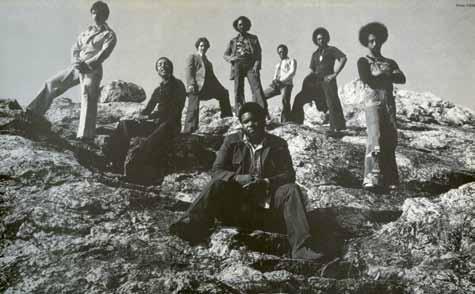

MM: 100%.
He’s also been credited as someone who played a role in the genesis of funk. i ’ve heard him say in interview that if you have a jazz background you can make instrumental music appeal to a pop audience and still maintain the integrity of the song. Like, if you understand what makes people feel a certain way it doesn’t matter what style of music it is. i hear that a lot in Pleasure. you were not exclusively a vocal group; there are ample breaks and changes in the songs. t he fusion element really does push the listener.
MM: Right. You are totally correct. We were a hybrid band because we love so
many different styles. It was important for us being in the basement and getting our stuff together. We could experiment and try all these different things that musicians have in their heads…and just work it out.
Later, on the Joyous LP we really connected to a lot of people on the East Coast. We were getting radio play and touring the US with acts like Cameo, Kool & The Gang and Earth, Wind & Fire. I remember when we played a show in Philadelphia at the Tower Theater.
We were shocked because there were so many fans of our music there to see us. That’s when we really knew we were on the right path.

and just to put this in context, you were about 21-22 years old?
MM: Yeah. We got a lot of encouragement from more established bands like Earth, Wind & Fire. Whenever they would come to the Northwest, even if we weren’t opening up their show, they’d call us and say, “Hey come out and hang with us.” And with Kool & the Gang…same thing. They were nice guys that wanted to see you make it.
t hat’s incredible. at what point did you become the bandleader of Pleasure? i imagine there were a set of responsibilities that came along with that role.
MM: It came together when we got signed to Fantasy. But we were a democratic band. We’d have meetings, make decisions, and then whatever those decisions were I would go out and execute them. I was the guy who would talk to the label or to Wayne.
but you also had a big role in songwriting.
MM: Yeah. I was one of the chief song writers along with Donald Hepburn, Michael Hepburn, Dan Brewster, Bruce Smith and Nate Phillips.
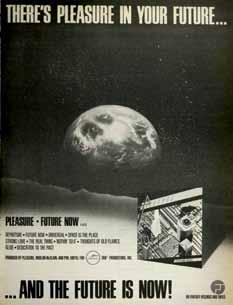
When writing a song for Pleasure, how would it start?
MM: I always started with some type of groove because I am a real groovebased guitarist. I’d come up with a rhythm idea and would usually play it for Michael to see what he thought. If he liked it then I would start expanding on it.
After we got to our fourth and fifth record we had a really good idea what we thought Pleasure was all about. Everyone in the band would bring their part to the table. For example, Bruce Carter had a certain style of playing without a doubt. So him hearing the demo and then adding his part to it made it come alive even more.
r ight…all those polyrhythms in there.
MM: It was just how he approached playing it. And same with Nate in how he played the bass. Once those parts were there, we would take that demo and turn it into a Pleasure song.
Speaking of the fourth and fifth record, i ’ve heard you say that Future n ow is really where things took off for the group.
What about that record in particular defined the Pleasure sound?
MM: By then we were so focused as a group. We decided we were going to produce the record ourselves and had really definite ideas of what we thought it should sound like. We were into having a horn sound but having the rhythm be even more aggressive - adding a certain amount of rock flavor to it. It wasn’t an overly exaggerated approach but there was more of a rock feel. And you feel the groove of it, too. You feel the soul of it. I would say it’s definitely one of Pleasure’s best records.
and there’s a great minimalism in those arrangements, too. o n a track like “g lide” the instrumentation is very present but there’s this groove repetition that hooks the listener, especially someone on the dance floor that needs that kind of thing to happen. i t’s as if you’ve stripped down the jazz to its bare essence and given the people this thing they didn’t know they like.
MM: Yeah. (laughs) Bands would tell us they’d use “Glide” as a way to see if a bass player could play. Many people tell me that to this day. If the bass player couldn’t play that song they couldn’t be in the band! It’s like the ultimate compliment.
What were your first forays in producing outside of Pleasure?
MM: Well, Wayne gave me the bug of wanting to learn how to produce. He was so engaging and great to be around. Early on I would go to the sessions to just hang out and watch. I always had producing in the back of my head. It was a natural progression for me.
After Future Now, I left Pleasure. I’d always been trying to produce. I was working with Jeff Lorber and a group called Shock. Around that time I started a company for production and songwriting called Mac Man Music with David Leiken of Double Tee Concerts. That’s become my main focus to this day.
a s i understand it, you leaving Pleasure was an amicable thing but, that being the band you grew up in, i imagine it may have been hard to leave.
MM: To me it was natural. As a musician, you always have a lot of stuff in your head, right? It’s natural for you to say, “Okay. I am doing this and it’s great but it might be cool if I do this over here, too.” It’s part of your growth. The challenge of being artistic is that you want to always say to yourself that you are growing. And it’s easy to become complacent when everything is going alright. I have always been the kind of person that, to this day, the thing I get up in the morning and love most is discovering music. I love music. Period. It has nothing to do with me playing it or saying I wrote it. It isn’t that. I love being around the process of music.
r ight…just being in the room.
MM: Exactly. I can be a part of it as a fan. I can be a part of it as a producer, associate producer, executive producer or nothing at all. I am just being a part of it. Over the last few months, for example, I have been working with Al McKay, former guitarist from Earth, Wind & Fire. I have literally enjoyed just being around him and hearing stories of how he got started learning the guitar. I’m just totally engulfed in it. So to me that’s the part of being a fan of music - just loving everything about it.
Part of my journey has been that I have made different changes in my career based on that love. It was a natural thing to go the way it did with Pleasure. We reached a certain place in our career and for me it was just time to do something different - to experience music in a different way.
Would you say that connection with process and being around music started at home? i imagine your parents must be musical.
MM: Not musical. They just loved listening to records. I am really the only musician in the family but that’s part of what’s great about it. My mother especially supported my decision to get into the music business
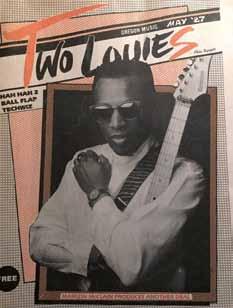
– from the time I asked her for a guitar and throughout my success. She’s been one of my biggest supporters.
The same goes for the community in Portland. In Pleasure, we were connected as brothers from the community. We came up out of the community and went national but it was really that community’s spirit which led us to where we went.
and even after you had toured the country with all these national and international acts i take it you would still come back and play for the community in Portland?
MM: Oh yeah. At the height of the band’s career we came back and sold out Portland and Seattle. It was incredible.
tell me about your experience with d azz band.
MM: I joined Dazz Band in ’85 and played with them all the way until last year. I am actually the longest Dazz Band member.
a round the time you joined they must have been riding high off of the single, “Let i t Whip.”

MM: Yeah. I was a friend of their producer, Reggie Andrews. He called me one day and said, “Marlon, Dazz Band is looking for a guitarist. Would you like to be in the band?” I said, “Yeah, I like that band.” So then he had me call Bobby Harris, the leader of the band. Bobby said, “Marlon, I know who you are. I saw you a year ago playing with Jeff Lorber. If you want the gig, you can be in the band.” So literally after that one phone call I moved to Cleveland and a week later I was in the band. By this time they already had two buses, a huge complex in Cleveland, and
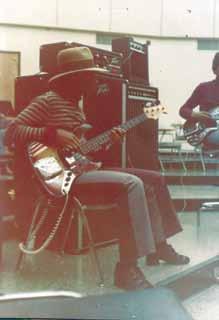
were touring all around the country.
and at this point, it’s almost like you’ve had a lifetime’s worth of musical experience…you’re only 30 years old.
MM: Yeah. (laughs) We did a lot of shows, a record on Motown, and then went over to Geffen Records. We had a great time. There were a lot of great guys in the group.
and while playing with them you were also songwriting and producing for numerous acts: En vogue, Kenny g, george benson, tower Power and even n u s hooz.
MM: What was crazy about that was when we were recording the Motown record we were at this studio in L.A. and I was in one room with Dazz Band and I had Nu Shooz over in the other room cutting vocals for “Point of No Return.” I was going back and forth! (laughs)
d id you ever think like, “a lright, now we’re going to do a supergroup track with both bands and just see what happens?”
MM: I didn’t. That would have been cool but I didn’t even think of it.
t hat n u s hooz LP, Poolside, is phenomenal. you helped produce parts of it. What was that like?
MM: I worked on a few songs and they worked with Jeff Lorber on a few songs. I also helped produce the original demo for “I Can’t Wait” that Warner Brothers rejected. This was before they went over to Atlantic. The best part of the story was when the guy over in Holland remixed it and made it a big hit.
r ight. i love that whole story. t hat said, you did ultimately put together a supergroup with u nited We Funk in the late 90s. i t was you, members of Con Funk s hun, d azz band, roger troutman, r ick James, s .o. s . band, Charlie Wilson from the gaP band…just an incredible lineup. talk about that experience and how people responded to it.


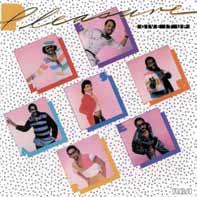

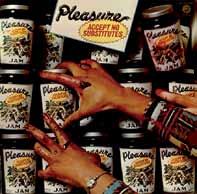






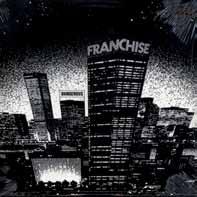

MM: Personally, it was one of the highlights in my career. I got a chance to work with all these artists I admired. We had fun. I got to know these guys. It was the first time I had worked with Charlie Wilson from Gap Band. We toured the country with 30-40 dates and really tore it up.
i t’s also worth mentioning that this group you helped create was the swan song for two of the biggest artists of our generation; these were the final recordings and performances that r ick James and roger troutman ever did.
MM: Yeah. It was a trip because obviously we didn’t know that at the time. But the record we made was their last which makes it even more special.
n ow i know you are constantly seeking out new music and developing talent. you’ve been managing artists including Charlie Wilson, Con Funk s hun as well as a l McKay formerly of Earth, Wind & Fire.
MM: It’s kind of natural. I mean, I don’t manage Charlie Wilson. I’m with the management company that manages Charlie, P Music Group founded by my buddy Michael Paran. I do work with Michael Cooper, Felton Pilate and Con Funk Shun. We put together their recent album, More Than Love. And I’m so excited to be working now with Al McKay. He and I
became friends in the early days of the Soul Masters, the band before Pleasure. He almost produced one of Pleasure’s records but it just didn’t work out. He is such an incredible talent. I can’t say enough.
i f you could be remembered for all the work you’ve put in over the past 40+ years, what would you like that to look like?
MM: Just a lover of music. That really is my spirit. Whether it’s being supportive of my son and his group, Made in L.A., or being supportive of my niece, Whitney McClain, and her music. Part of my spirit is being a fan of music. So when I hear their music or music in the community I want to get involved and try to help. I grew up in a community, so that’s how I look at it. I’ll always be there to help.
b obby s mith is a journalist and dj based in Portland, o regon. His blog-turned-radio show, n ight school, features modern soul, boogie, and outsider funk selections from across the globe. He has contributed to Wax Poetics and Xray FM. More information may be found at www.nightschool.us

The Mudd Club
77 White Street New York City
$ 5 Average admission, varies with live entertainement.
While in Uptown New York Studio 54 was on 54th Street, all was glitz and glamor, with smoke machines to cloud your vision and a bit more besides, with confetti raining down from cannons, south in Downtown things were rather more intellectual and artistic. But no less legendary. Number 77 White Street in the TriBeCa district, to the south of SoHo and Greenwich Village, a few hundred yards from the Hudson River. It was here that the Mudd Club opened its doors in October 1978, founded by publicist Steve Mass together with curator Diego Cortez. The Mudd Club closed in the spring of 1983. A regular noted, “At the end, it was not much fun anymore. I mean, it had just become kind of like the hangers-on to the hangers-on at the Mudd Club”.
Mudd Club featured a bar, unisex bathrooms, and an art gallery curated by Keith Haring on the fourth floor. Live per-

formances there included new wave, experimental music, performance art, literary icons Allen Ginsberg and William Burroughs, and catwalk exhibitions for emerging fashion designers Anna Sui and Jasper Conran. Performers included New York no wave bands such as
DNA, Rhys Chatham, Nona Hendryx’s zero Cool, the Contortions, Tuxedomoon and Jean-Michel Basquiat’s band Gray. In 1979, Talking Heads performed songs from their new album Fear of Music. Tim Page produced several concerts at the Mudd Club in 1981, in an attempt to meld contemporary art music with rock music and pop music. On the dance floor, DJs David Azarch, Anita Sarko and Johnny Dynell played a unique mixture of punk rock, funk music and curiosities. From the start it functioned as a post-punk “amazing antidote to the uptown glitz of Studio 54 in the ‘70s”.
Article from the book: Night Dancin published in 1980. Text by Vita Miezitis and Photographs by Bill Bernstein.
Anti Disco dress: Call the Mudd Club for anti-disco dress code for the month. Punk out, wear old clothes, chic out or try your luck getting in with jeans and a tee-shirt. Anti-DiscoScene: The telephone tape lists upcoming Mudd Club events like old movies, new wave, rock and soul performers and fashion shows with themes like the “asphalt jungle.” A dress code for the

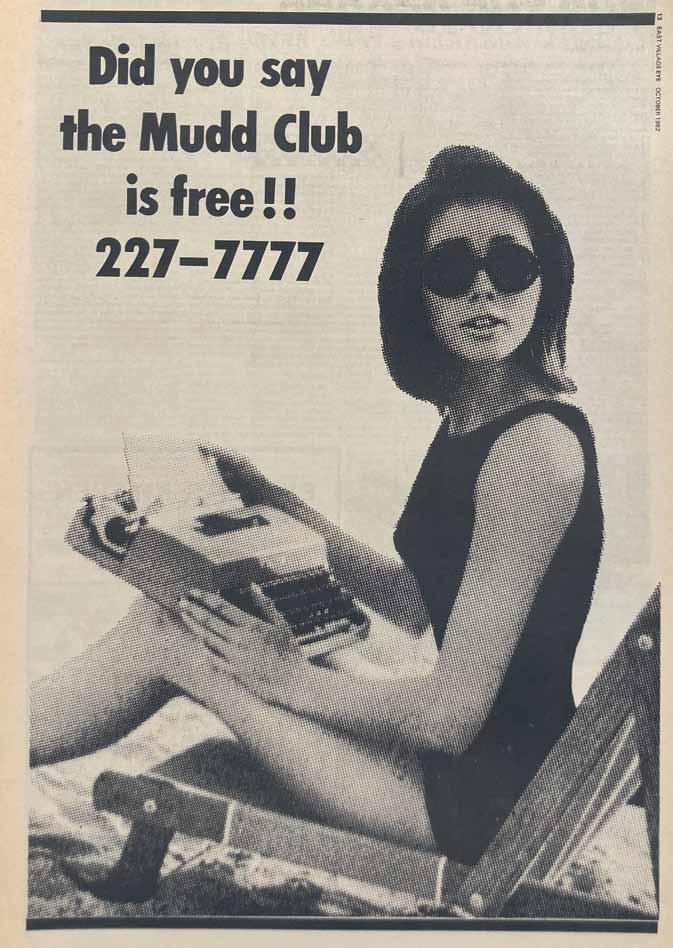
month is given, with suggestions like military and Hawaiian drag, Frederick’s of Hollywood and leisure suits in patterned Orlon.

The deejay spins rock, new wave and oldies. In fact, he spins just about every kind of music you can imagine-at earsplitting levels, no less that is, every kind of music but disco.
The room, stage and dance floor are tiny, dark, undecorated and are conspicuously lacking in disco light shows or hardware. The Mudd Club is an anti-disco. Anyone dancing the hustle here would more than likely be bounced out the door, booed and hissed, or stoned and safety-pinned to death. The mere mention of disco sends Mudd Club regulars running off, gagging, choking, screaming in agony, squealing and holding their ears. The club is also a goof, a spoof of a Studio 54- type disco. When the club is crowded, a doorman or woman decides whether or not you get in past the Mudd Club chain (as opposed to the velvet rope at 54). Essentially, though many Mudd Clubbers would be quick to deny it, you could take anyone from the Mudd Club, put them dressed “as is” in Studio 54, Xenon or G.G.’s Barnum Room, and they would fit right in. According to one Mudd Clubber, “It’s a joke to try to get into the Mudd Club, but it’s sick to put
yourself through the real humiliation of trying to get into Studio 54. I would never subject myself to that. Besides, 54 plays disco music. “
The Mudd Club is outrageous and fun, so long as the punk types don’t get too punky pushy and act like spoiled brats. The dance here amongst people “punking out” is the spastic. They rock back and forth with mechanical arms and legs, some throw themselves around the dance floor-usually into other spastics-or

jump up and down in place like a child having a tantrum. Other people dance freestyle, twist or rock ‘n’ roll 50’s style.
Mudd Club People:
Downtown chic, punk and other new wave types frequent the Mudd Club. Most are in their late teens and early 20’s . A growing number of “older” people (20’s and early 30’s) who go to this trendy club actually mix it with discos like Xenon and Studio 54. The crowd is international college students, professionals, artists. People come from all over the metro area. Rock and new wave bands not only play here, but frequent this club as well. Limousines out front are not an uncommon sight. Syn -







Pat Vogt Collection: FUTURA 2000 / BEYOND WORDS Original flyer designed by Futura2000. One of Pat Vogts most treasured flyers in his collection. On April 9, 1981, a graffiti exhibition called “Beyond Words” opened at the Mudd Club. Keith Haring curated exhibitions at Club 57 and later the Mudd Club, two downtown venues that acted as important cultural hubs for the artists of that era. Haring invited Futura (Lenny McGurr) and Fab Five Freddy (Fred Brathwaite), two of the most renowned graffiti artists of the time, to curate an exhibition of their peers. this show marked an important moment when the uptown Manhattan and Bronx graffiti and Hip Hop scene coalesced with the Downtown world of Keith Haring, Jean-Michel basquiat and others.the exhibition included rammellzee, Crash, Haze, Zephyr, Lee Quinones and many others.
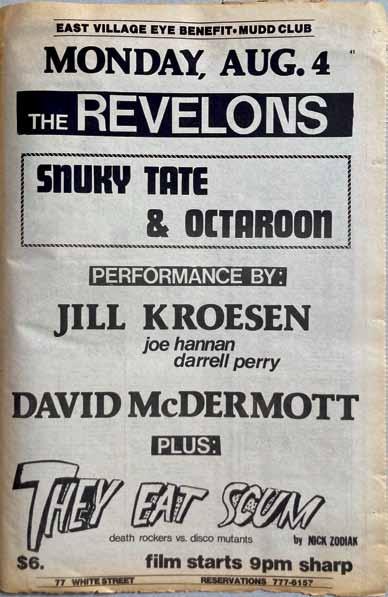
ad from the East village Eye-Pat vogt Collection


thetics, leather and stretch pants are in. Safety pins and nails, old pointy-toed shoes, punk buttons, dog collars and chains serve as accessories.
Dark eye makeup for both men and women is popular. Hair is greased and worn in unisex styles, often cropped short on top and messed up, sticking up and out in all directions similar to old Raggedy Ann and Andy dolls. Bright blue dyed hair is popular. Sometimes people just add a touch of streaking color, for instance, orange highlights to black hair. One woman I saw had half a head of black hair and half a head of white. They come to the Mudd Club because they like the music and they like to dance. Ben, a recent college graduate, likes the fact that the Mudd Club is so small and has no pretentious decorations. He hates “synthetic disco music, the commercialized light shows and the outrageous rip-off prices disco owners charge for entry.”
Sandra, twenty-two years old, who is a “punk by night” and works in the publishing industry by day, says, “I think people who go to discos are all brainwashed by the sugar sweet music and lights. It’s a total manipulation trip. At the Mudd Club, we stick to raw-sounding rock and to the basic gray and bare and ugly look.” Becky, a photographer and student, comes
to the Mudd Club occasionally because she is intrigued by the punks and sympathizes with much of what they are trying to say in their dress and lifestyle. However, she says many of the Mudd Club punks are just into playing “what they think punk is,” for instance, acting mean. “In England the punks are political. Their dress is outrageous; few have any money. They live what they preach. They’re also friendly,”


says Becky, who spent time in London. “Here, quite a number of punks just get into being obnoxious and dressing ugly.

“In fact, I’ve run into a few people who only punk out when they go out at night or some who come to the Mudd Club, put
on all the crazy makeup and change into old or leather clothes in the bathroom here. They live at home and say their parents won’t let them dress punk at home. Now, what kind of punk statement is that when part of the punk philosophy is based on disgusting the over-thirty generation?” she asks. “They run around here acting tough, pushing people around and swearing, but they’re basically so intimidated, they won’t even put on their punk clothes in front of their parents or outside the confines of this club.” Paul a twenty-year-old Frenchman vacationing in New York, says, “I go to discos in France and am told that the clubs I must visit while in the city are Studio 54, Xenon and the Mudd Club. It’s quite different from anything I’ve seen elsewhere. I basically love to dance and love all types of music. A club like this is most interesting, because it gives me a chance to meet people and see what Americans my own age are doing. “
Born James A. Johnson, Jr. in Buffalo, New York, Rick grew up in the Perry and Willard Park Projects, later moving to the Cold Springs section of the Gtyof Buffalo. Rick nurtured his early music skills on pots and pans; playing on anything that produced a sound. He hummed and then he sang; starting first in the choir of St. Bridget’s Roman Catholic Church where he also served as an alter boy. He later joined the Cadet Drum Corp. Rick loved music and played the congos, bongos and danced under the tutelage of Malcolm Erni. Rick was involved in the beginning of the African Cultural Center. He played in the Bennett High School Band and sang in street corner groups with lifelong friends, Levi Ruffin and Jimmie Steward.
Rick was also an athlete; engaging in sports at Public School # 53, football with the Masten Minutemen Football Team and basketball at the Humboldt YMCA.
Rick enrolled in the United States Navy at age 15. However, he found the service to be too disciplined. Rick was active in the Toronto music scene in the mid 60’s as a member of the hugely popular Mynah Birds, which also included future Buffalo Springfield members, Neil Young and Bruce Palmer. He relocated in the early 70’s to Britain, where he formed the group Main Line. Early in his career he co-wrote for Motown artist Bobby Taylor and the Vancouvers.
He signed in the early 70’s with Motown as a duet with Rock Legend Neil Young but the LP was not released.
Rick was signed again into Motown in 1977. He drew inspiration for his music from his rock background and funk pioneers George Clinton, Sly Stone and Buffalo’s Dyke and the Blazers. But, his music was
fresh and original, blended with riffs and rhythm from all his Buffalo based bands. In 1978 he scored his first No. 1 hit and top 20 popular hit entitled “You and I.” Quickly following were the tunes, “Mary Jane” and “Bustin Out.” By this time Rick was considered a star and creator of a new sound called “Punk Funk”
Rick’s career was soaring by 1981 when his album went to No. 1 on the R & B charts and No. 3 on the pop chart. The multi-platinum LP produced by the No.1 R & B “Give It To Me Baby,” but its No.3 successor “Super Freak” enjoyed a longer life with a sample used by Me Hammer on “U Can’t Touch This.” This record sold over 20 million LP’s and launched the samlpling craze of Rick’s music.
Throughout the 80’s, Rick found huge success at Motown, producing hits for Teena Marie, Smokey Robinson, the Temptations, Eddie Murphy, the Mary Jane I Girls, Val Young, the Stone City Band (His Heart and Soul), Process and the Doo Rags. Scoring hits like “Standing on the Top,” “Party All the Time,” “Ebony Eyes,” “My House,” and many many others. Rick’s road tours set many records in New York Gity, Los Angeles, San Francisco, New Orleans, Baton Rouge (Still Standing) and Memphis breaking hometown record. His tour was a worldwide success. With the onset of rap music and sampling, Rick’s music surfaced as a top choice to many artists such as EPMD, LL Cool J, Jay- z, Mary J. Blige, Mariah Carey, Big Daddy Kane, DJ Quick, Snoop Dogg, Jennifer Lopez and many others.
James worked with many other artists such as Val Young, Kanye West, Nelly, Mya, and others who found platinum hits in Rick James. Rick was the first major artist to use rappers in his music and tours.

Grandmaster Flash appeared on the “Street Songs” Smash LP and tour. Rick was recently honored with the heritage lifetime achievement award from ASCAP. At the ceremony he announced plans for his new CD. Rick also received a Grammy for his work on the “Beverly Hills Cop” soundtrack. At the ASCAP awards it was revealed that Rick was the most sampled artist of the millennium. Today one can’t watch TV without hearing RickJames. From Super Bowl commercials to movie. This truly creative man roared back even stronger this year thanks to a series of hilarious sketches’ on Comedy Central’s “Chappelle’s Show.” The show’s host/ creater, Dave Chappelle was in talks to star as James in a film based on his upcoming autobiography, “Memoirs of a Super Freak.”
VH1 stated that “Behind the Music with Rick James” was the most requested program in the series. After a recent stroke, Rick said that, “God sat me down to pay attention and told me to get back up and hit the stage, and I’m enjoying it.”
Rick was a true family man. He loved his children Ty, Ricky and Tazman. He loved his brothers and sisters Carmen, Camille, LeRoi, Sheryl, Alberta, William (deceased) and Alicia (Penny) the youngest. Rick was proud of his cousins Mayor Carl B. Stokes, and brother Congressman Louis Stokes and often bragged about them. He was

also very proud of cousins Melvin Franklin of the Temptations, James Brown, Danny Glover and Dr.Robert Scott. Rick was a true family man, always stating family first. His family went beyond blood and included Teena Marie, who will be forever remembered, his close friend William Thorton, Linda Hunt, Charles and Eddie Murphy and family and Jermaine Jackson who have been beside Rick for years.
Rick maintained a strong love for Berry Gordy and the entire Motown family long after leaving motown and he knew they loved him. His beloved daughter, Ty is pursuing a career in music. His son Ricky is an accomplished artist. His youngest son Tazman is 12 with a great life ahead. Rick cherished his two granddaughters, Jasmin and Charisma. Rick’s brilliant career was cut short suddenly when he died on August 6, 2004 in his sleep.
He will be forever deeply missed by his loving family and friends, as wells as his many adoring fans.


courtesy of Brandon Himmel

april 11, 1982
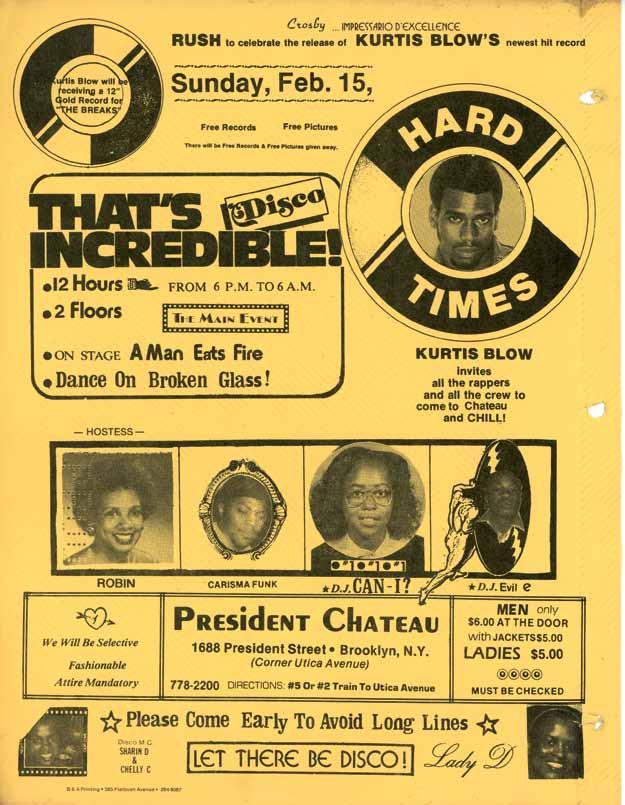
15,

January 18, 1981 front

January 18, 1981 back


February 11, 1983 front
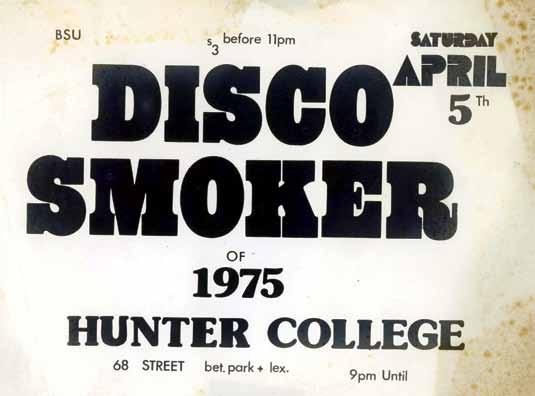
april 5, 1975

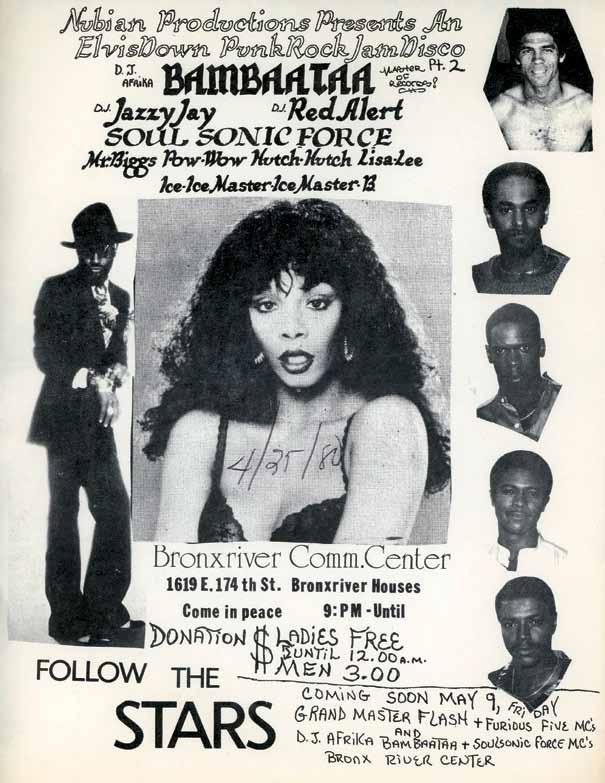
25,
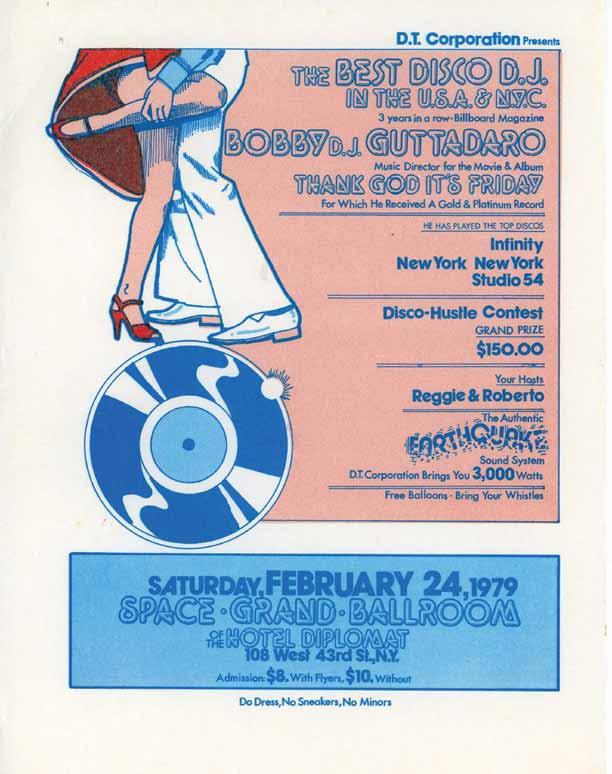
February 24, 1979

10, 1982

december 21, 1979
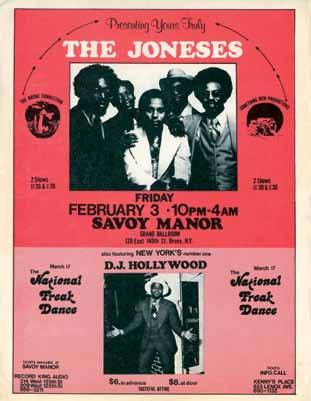
February 3 ,1978
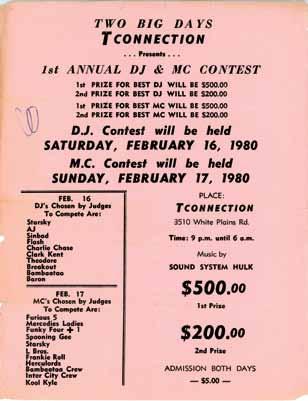
February 16, 1980

February 11, 1970

March 3, 1982

January 9, 1970

september 3, 1982
Article in Vinyl Tracks 1979
Volume Three, Number 8
Taana Aida Gardner is basicalIy a sweet, unjaded 19 year-old whose first studio recording (“Work That Body”) sold 60,000 copies and produced a disco classic. Her inviting vocals and the insane bass hook had dancers pumping for months at the heights of Top 10.
Born in Newark, New Jersey, Taana began singing at age five via opera coaching from her grandmother. By age eight, as the youngest member of a local singing group. Taana and The Darnettes, she performed at various local community, school and church functions through New Jersey. Later as part of the Harlem Children’s Theatre, she sang and danced in various stage productions at Lincoln Center and the Apollo Theatre.
Her home has been a big part of her young life, too. Since age seven Taana practically raised her younger sister and brother, protecting them from street hoodlums, as well as taking care of most household chores for her mother.
Shortly after she graduated from High School (Westfield- Class of ‘78)’ Taana met Kenton Nix (Producer of “Work That Body”) at a party. He heard her sing, swept her into the studio and the rest is in the grooves.
The album “Taana Gardner” was released four weeks ago to rave reviews. Already two cuts are climbing on the disco charts;”When You Touch Me” and “Paradise Express” (written about Paradise Garage in New York). Today Taana lives in Brooklyn. She enjoys tennis, roller-skating and cooking shrimps campi. Some day she hopes to work with underpriveleged children. Right now she wants to concen -
trate on writing some of her music. Over-all,she’s unspoiled-except or limousines and quiet, until she’s had a few Pina Coladas. She won’t touch drugs. “Lady Sings The Blues” deeply impressed on her what drugs can do to people.
Natalie Cole is her idol, and she’s dying to meet Richard Pryor.
Just recently Taana started constructing a blanket for Grace Jones’ baby using a unique Jamaican method of construction. Certainly hope Mama Jones doesn’t decide to keep the garment for herself. Knowing her she might decide to re-design it for her maternity wardrobe.



